One thread at a time

A FRESH SET OF EYES
New trustees tackle old problems
City College of San Francisco | Fall 2020
SAVING THE PLANET
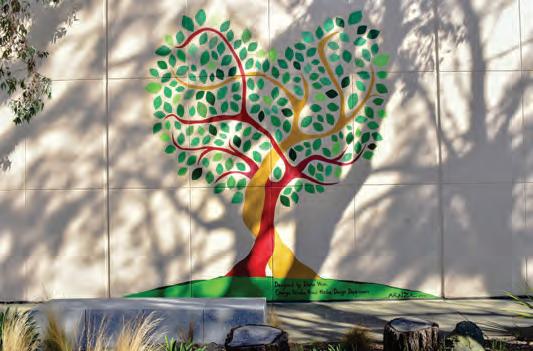
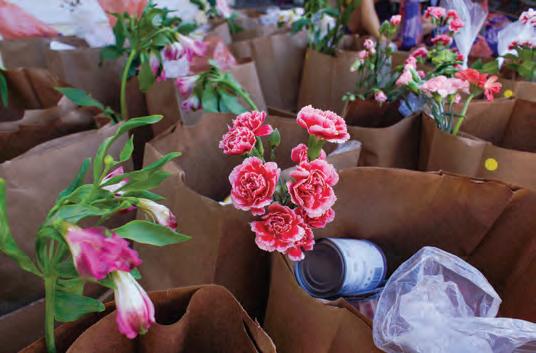
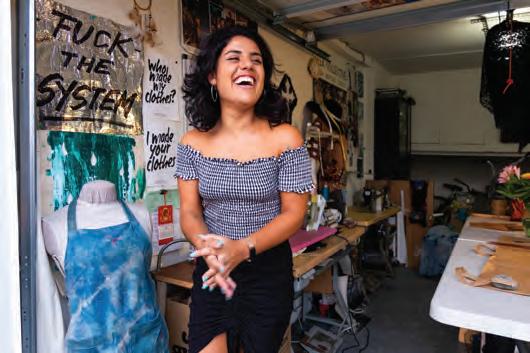
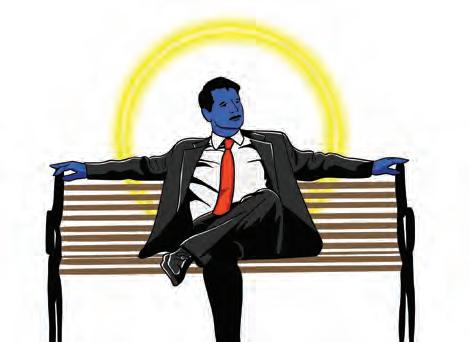
CONTENTS 09 23 28 13 Fall 2020 From Yoga Mats to Smartphone Apps It Takes A Village Sustainably Stylish No More Silence. No More Violence. Eastern philosophies gain traction in a 2020 world Third Parent Family feeds more than bellies during the pandemic Fast fashion steps aside for eco-conscious apparel Project SURVIVE dismantles rape culture through education Etc Magazine
New Blood On the Board
San Francisco elects new trustees to help steer college out of it’s financial turmoil

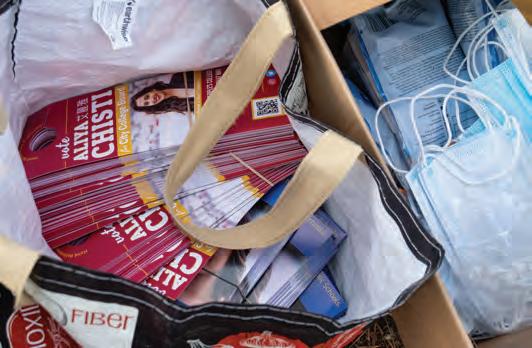
Off the Gridiron Into the Zoom

With football season postponed, the Rams charge into unknown territory
Editor in Chief Meyer Gorelick
Managing Editor Abraham Davis
Content Editor Eleni Balakrishnan
Design Director Jasmine Castillo
Director of Photography Emily Trinh
Illustrator Bobby Ramirez
All Jazzed Up and Nowhere To Go
Neighborhood organization provides a safe place for musicians to practice
Staff Writers & Photographers Charles Butler
Kevin Kelleher
Bo Lenschau
Megan Ogle
Justin Vuong
Melvin Wong
Jennifer Yin
Adviser Jessica Lifland
Fall 2020 1 33 19 03
On the Cover:
Photo by
Editor’s NotE

This has been an unbelievably awful year. The pandemic and wildfires, among other catastrophes, have made life terribly fraught and challenging.
After a half semester of remote production this past spring because of COVID-19, Etc Magazine kicked the tires on a fully remote magazine this semester. What looked like an uphill slog turned into a productive journey.
On Tuesday Nov. 3, while almost everyone else was glued to cable news to see who might be the next president, our staff was out covering a local election to see who would be City College of San Francisco’s new trustees.
The first piece, “New Blood on the Board,” follows four promising campaigns. I dug into the candidates’ backgrounds and platforms while our photographers pounded the pavement alongside them as they canvassed for votes.
I’m thankful that Justin Vuong chose to take a break from his “soul-sucking property management job” (his words) to become a writer for Etc. His story “From Yoga Mats to Smartphone Apps” takes the reader on an exploration of mindfulness and draws on commentary from City College’s mindfulness experts about how this modern version compares to its spiritual origins.
Back Cover:
Design by Janel Mitchell, Emerge Studio/Design Studio Practicum Visual Media Design Department.
Special Thanks:
Etc Magazine would like to thank Colin Hall, John Seckman and Lorraine Leber’s design students for submitting their back cover promo ad designs, our printer Sanjay Sakhuja with DPI Printing and Camera Bits who supplied us with Photo Mechanic.
About Etc Magazine:
Etc Magazine is an award-winning student publication. It is written, edited, photographed, illustrated, designed, produced and distributed by students enrolled in the Journalism program at City College of San Francisco.
The magazine is devoted to fair and objective reporting. We cover the important issues facing the college, its students, faculty, staff, administration and the surrounding community. Any opinions expressed in the publication represent the views of the students who authored them. Etc does not purport to represent the views of the school’s administration. The magazine comes out twice a year — once in the spring and again in the fall.
Photo Editor Emily Trinh shot and wrote “Sustainably Stylish,” which focuses on green fashion and two former City College students who are working to break sustainable clothing into the mainstream. Trinh’s piece will inspire readers to be more thoughtful the next time they shop for clothes.
I never got the opportunity to meet Charles Butler in person this semester, but I was frequently soothed by his smooth southern drawl as he updated us on his story “Off the Gridiron Into the Zoom.” Butler shows how the Rams football team adapted to make the most out of their time off the field with the season postponed.
Bo Lenschau’s “It Takes a Village” showcases the selfless and vital work of husband and wife team Daveea Whitmire and Whitney White. Lenschau takes us behind the scenes of their nonprofit dedicated to making sure folks have all the tools necessary to empower themselves, starting with food in their cupboard.
Jennifer Yin’s piece “No More Silence. No More Violence.” highlights the important services that Project SURVIVE provides to combat sexual abuse and empower survivors. Yin, a gifted artist, illustrated and shot her own story.
We end this issue of Etc with Megan Ogle’s look at the advocacy of Mario Guarneri, who is fighting to keep Bay Area musicians well-rehearsed and compensated. “All Jazzed Up and Nowhere to Go” takes the reader into a warehouse where musicians have secured a safe space to collaborate during the pandemic.
Trinh and photographers Kevin Kelleher and Melvin Wong continue Etc’s legacy of firstclass photography, despite the many obstacles created by COVID-19. Their dedication and constant availability made production of this issue possible.

Design Director Jasmine Castillo not only laid out this issue in her typical elegant fashion, but set up a template for future issues, in case we never come across a designer of her ilk again.
Adviser Jessica Lifland’s relentless drive inspires this magazine’s award-winning content each and every semester. Her continued leadership and vision keep us on track and help us excel.
In the face of this year from hell, our talented team has rallied and made a magazine I’m truly proud of.
Meyer Gorelick, Editor in Chief
2 Etc Magazine w
Emily Trinh for Etc Magazine. White cotton fabric soaks in a tub of dye made from dried, crushed and cooked cochineal bugs.
City College of San Francisco SAVING THE PLANET One thread at a time New trustees tackle old problems A FRESH SET OF EYES
NEW BLOOD ON THE BOARD
San Francisco elects two new trustees to help steer the college out of its financial turmoil
Story by Meyer Gorelick
Only two out of the four incumbents sought reelection to the City College of San Francisco’s Board of Trustees this November, as the school continues its climb out of a deep financial hole, further exacerbated by the COVID-19 pandemic. Board President and Vice President Shanell Williams and Tom Temprano faced stiff competition from a diverse slate of nine hungry newcomers for the four open seats.
City College’s faculty union, AFT 2121, endorsed challengers Alan Wong, Aliya Chisti, Anita Martinez and Han Zou. They did not endorse either of the two incumbents running for re-election. “During a time when layoffs are happening left and right, class cuts are happening left and right, it was a really hard sell,” AFT 2121 Political Director James Tracy says. “The incumbents had a big job to convince our members to endorse them again.”
Wong, the candidate who outraised everyone with $78,000, according to the San Francisco Ethics Commission’s Campaign

Finance Dashboard, narrowly won the fourth seat. He is the education policy adviser to Sunset District Supervisor Gordon Mar.
Wong was born and raised in the Sunset District by Chinese immigrant parents who took English as a Second Language, ESL, courses at City College upon arrival in San Francisco. Jimmy Wong, his father, then discovered and completed the culinary program at City College.
“Through that training he was able to find a job at a restaurant, and later work as a union hotel cook at Grand Hyatt on Stockton Street. It was through that job that he supported my family and four in-laws for two decades,” Wong says. “We were able to have healthcare, a roof over our heads and survive in the big city.”
“My mom, she took ESL classes. It helped her talk to family members, be self-confident and just be happy and integrate,” Wong adds.
Wong took classes at City College while still a student at Abraham Lincoln High School, and accumulated enough credits
Fall 2020 3
Candidate and now Trustee-elect Alan Wong watches a monitor for results on election night during an outdoor gathering at The Lister Bar in San Francisco. (Kevin Kelleher/Etc Magazine)
to graduate from University of California San Diego when he was only 19. He then earned a master’s degree in public affairs from University of San Francisco. After working for years as a union organizer for Service Employees International Union, SEIU, in San Francisco, he joined the staff of his neighborhood supervisor Gordon Mar and began advocating for City College.
Wong worked on the Free City legislation in 2019 that secured $15 million annually to fund City College tuition for San Francisco residents for 10 years after an initial two-year pilot program.
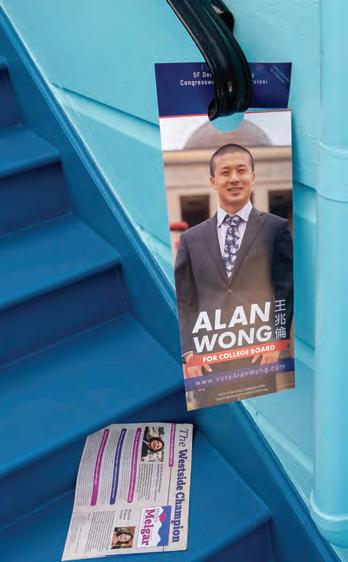

He is looking forward to leveraging his public service experience and connections to boost enrollment and to right the ship financially.
“The college is in a dire situation,” Wong says. “This year they borrowed $21 million from the retirement fund, and in 2024-25 there is a $50 million hole in the budget.”
On election night, candidates, politicians and staffers slowly make their way to
the outdoor patio at The Lister Bar in Park Merced where District 7 supervisor candidate Myrna Melgar hosts an election party. Wong alternates between mingling with folks and refreshing the election results on his phone. It’s too early to call but the initial returns are promising.
“I’m glad it’s over. I’m feeling nervous but good,” Wong says, sitting in the top four with 66% of the votes counted.
By the time Aliya Chisti, another promising candidate, arrives, the energy at The Lister has gone from subdued to excited. New reports show Chisti and Wong solidifying their position behind incumbents Temprano and Williams
as the four elected trustees.
“I feel good and anxious. At the end of the day, whatever happens, we know that we worked so hard,” says Chisti.
She is Free City’s head program administrator at the SF Department of Children, Youth and Their Families. Like Wong, Chisti is a San Francisco native, and will be the first Muslim woman elected to
public office in San Francisco.
“I grew up in a low-income household, and the only path out of poverty I saw was through education,” Chisti says.
Standing atop Holly Park in Bernal Heights with her campaign managers and her father at a weekend canvassing event in early October, Chisti said that her current role and background in higher education puts her in a good position to understand the challenges City College faces and advocate for the school at the local, state and federal level.
She was a Fulbright Scholar teaching English in North Macedonia, then went on to earn a master’s degree in education policy from Columbia University. She was also an education policy intern for U.S. Sen. Patty Murray of Washington.
Chisti emphasizes the need to close the educational opportunity gap that students of color face and which she experienced firsthand. She highlights the stark difference in the education she received in crowded classrooms at Aptos Middle School, located down the road from Ocean Campus, compared to the classes she attended through a summer program called AIM High.
“The classes were like 10 people, and
4 Etc Magazine
“The college is in a dire situation. This year they borrowed $21 million from the retirement fund, and in 2024-25 there is a $50 million hole in the budget.” — Alan Wong
College board candidate Alan Wong delivers promotional materials in the Sunnyside District of San Francisco. (Kevin Kelleher/Etc.Magazine)
A flyer for Alan Wong hangs on a house railing in the Sunnyside neighborhood of San Francisco, hung there by the college board candidate himself. (Emily Trinh/Etc Magazine)
there was a teacher and a support staff and they knew your names,” Chisti says about AIM High.
To improve outcomes for Black and Brown students who are matriculating at a lower rate than white and Asian students, Chisti says that the school must prioritize serving them via grants, advisors and hiring faculty of color.
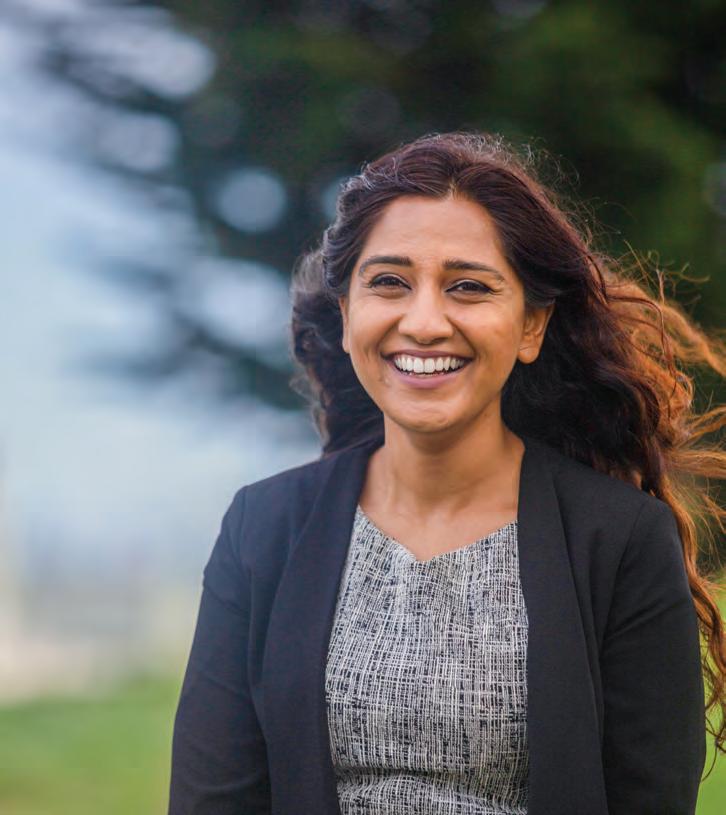
Her top priority is to fund emergency grants that will give low-income students money to cover expenses, including books, laptops, housing, food, healthcare and childcare.
Although they didn’t win this time around, Han Zou and Anita Martinez, the other two candidates endorsed by AFT 2121, will likely continue to influence education policy in San Francisco.
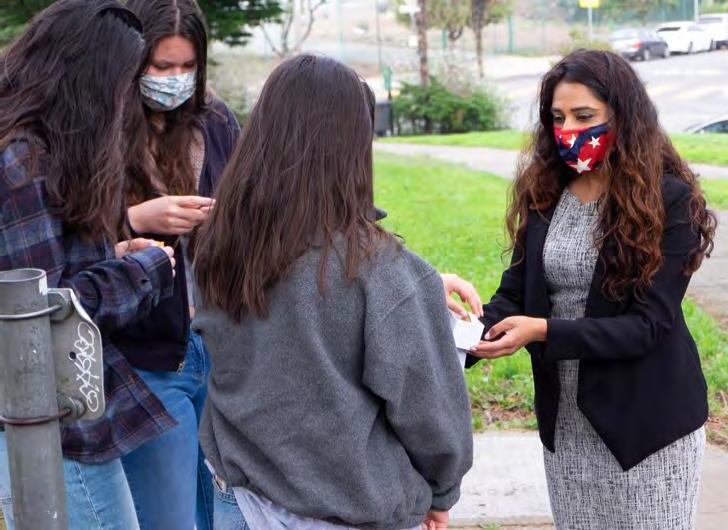
Zou, a legislative aide to Supervisor Matt Haney, is also the son of Chinese immigrant parents and thinks it is important for the Chinese community in San Francisco to continue having representation on the Board of Trustees with Trustee Ivy Lee choosing not to run for re-election.
Zou wants to bridge the gap between Asian Pacific Islander communities and Black and Brown communities. He says that traditionally the Chinese and Black communities have been pitted against each other, sowing division and competition for resources instead of solidarity.
Zou says that anti-Black sentiments are a problem in Chinese communities often fueled by media coverage.
“There really is a lot of anti-Blackness in the Asian community that we need to examine and we need to call out, and we need to make sure it doesn’t cont inue.”
Zou also emphasizes the central role that City College must have in San Francisco’s pandemic recovery effort.
“People are going to be turning to City College to get new skills, get new jobs, get new degrees. What happens over the next few years at City College is going to be importa nt not just to the college’s survival, but to the city’s recovery as well,” he adds.
He says that he will continue working to support City College in any way he can.
“I’m disappointed but happy with the campaign I ran given the circumstances,”
Fall 2020 5
College board candidate Aliya Chisti stands for a portrait before going out canvassing in Bernal Heights. (Kevin Kelleher/Etc Magazine)
Aliya Chisti coordinates with volunteers for her campaign before they head out to canvas in Bernal Heights in October. She was elected to the Board of Trustees in November. (Emily Trinh/Etc Magazine)
the four folks who won election and reelection are committed and dedicated trustees.”
Fellow candidate Anita Martinez spent 20 years at City College in various capacities, ranging from ESL instructor to president of the Academic Senate. She was dean of st udent affairs and interim vice chancellor of instruction.
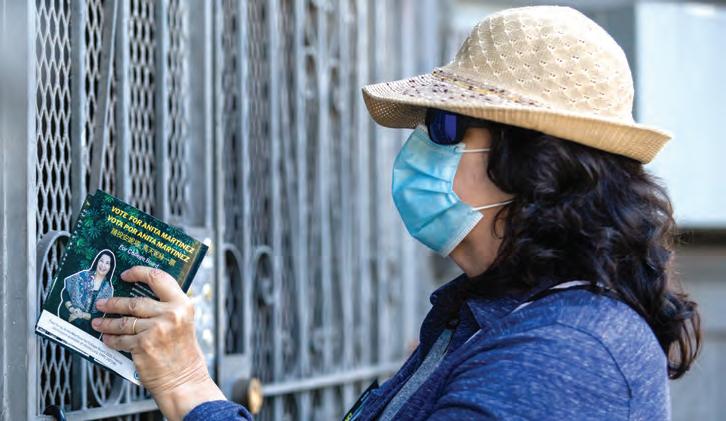
When discussing the candidates, AFT 2121 Political Director Tracy says of Martinez, “She’s probably the most loved one out of our members.”
Martinez hasn’t seen the college moving forward from its fiscal turmoil and decided to come out of retirement after being asked to run by students and faculty in February.
“Only slightly over a half of a percentage point separated me from fourth place,” says Martinez who finished barely behind Wong in the end. “That’s not bad, considering that my campaign spent a third of what the fourth place person spent and had fewer endorsements from elected officials.”
She will continue enjoying retirement after a long career at City College and plans to spend more time with her daughters and grandchildren.
Martinez and Zou will monitor City College’s progress and neither rules out a future campaign.
“We’ll see,” says Zou. “The next election
is in two years and a lot can change, but I’ll do whatever I think is most helpful for City College.”
Back at The Lister on election night, w ith the results solidifying and her victory seeming imminent, Chisti announces, “It’s time to get to work. I’m going to have to learn the ropes, learn the lay of the land and make myself informed.”
Riding high on her projected victory, Chisti takes her turn at the podium to thank her supporters.
“When I was working on my policy platform I came across a paper that refers to community college as people’s college, democracy’s college, and I fell in love with that term, and we’re going to bring it back,
because City College of San Francisco is the people’s college!” Chisti says into the microphone.
With the election behind them, Chisti and Wong will be part of the process of choosing a permanent chancellor, and both say that making the correct selection will be vital for the college’s future. They want someone with sound fiscal oversight skills who will be transparent and inclusive in their decision making.
Boosting the school’s headcount is also paramount. City College is still struggling to return to its pre-accreditation crisis enrollment heights, when annual enrollment was about 30,000 higher than today. When the Accrediting Commission for Community and Junior Colleges threatened to revoke the school’s accreditation in 2013, a mass exodus of students (and funding) began. City College still faces a long road to recovery.
“Currently there are 1,500 students that are living in San Francisco that go to community colleges outside the city,” Wong says. “That’s a lot of lost revenue. Why aren’t they coming to City College?”
During his campaign, Wong spent each weekend canvassing with volunteers like James Creed, a 20-year-old student at College of Marin, COM, who graduated from Mission High School. He chose to attend COM after graduating because the introductory classes he needed to take were full at City College.
“I chose to go to Marin,” Creed says. “It was a lot easier to get classes there because the campus is a lot smaller. And I know a

6 Etc Magazine
Anita Martinez campaigns door-to-door in October. She was running for a seat on the City College Board of Trustees which she lost by a very close margin to Alan Wong. (Kevin Kelleher/Etc Magazine)
Kathie Piccagli, left, opens her door for Han Zou, right. Zou was campaigning in the Sunnyside neighborhood for a seat on the City College Board of Trustees back in October. (Melvin Wong/Etc Magazine) Zou says. “I’m glad
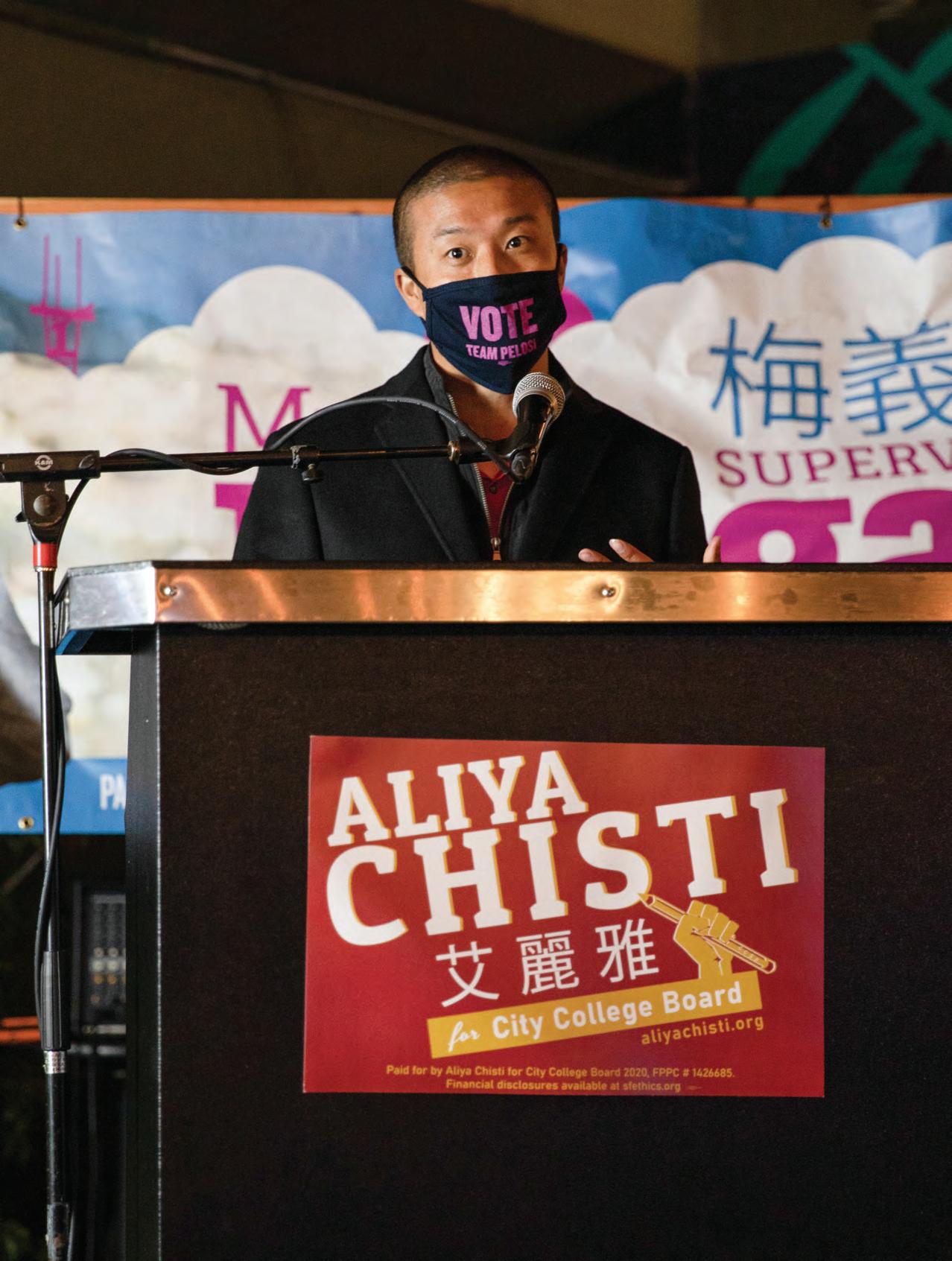 Alan Wong addresses an audience at The Lister Bar on election night in November. (Melvin Wong/Etc Magazine)
Alan Wong addresses an audience at The Lister Bar on election night in November. (Melvin Wong/Etc Magazine)
lot of friends from high school, they also did the same thing, they didn’t go to City College because it’s too hard to get classes.”
While the effort to build enrollment is crucial, trustees are also responsible for advocating at the local, state and federal level for funding. Chisti points out that the distribution of federal aid from the Coronavirus Aid Relief and Economic Security, CARES, Act was inequitable in how it served community colleges.
“The way that community colleges got money (from the CARES Act) was based on full-time equivalent status, FTES, and in order to have one FTES, it’s like two part-time students,” Chisti says. “Community colleges serve significantly more part-time students, so they received a lot less money than even for-profit colleges. That’s an issue.”
Wong and Chisti will both keep their full-time jobs on top of trustee duties, as do almost all the current board members, since trustees are only given a $500 monthly stipend. Finding the time can
prove incredibly challenging, according to departing trustee Ivy Lee, who was appointed by Mayor London Breed in 2018.

“I think to really do the job right you need 20 hours per week, and I just don’t have that to give anymore,” says Lee, who works full-time as a policy advisor to Breed and has three children.
Lee is confident that Wong and Chisti are up for the challenge.
ensure that no more surprise deficits arise.
Chisti echoes Wong’s urgency in resolving financial insecurity. “We have to strengthen the checks and balances in the budget process, and strengthen our fiscal controls,” she says.
Wong has been reading up on City College, particularly the budget, closely following the board meetings and mixing with City College stakeholders and other trustees.
His top three priorities moving forward are closing the opportunity gap for students of color, getting students into jobs to support the COVID-19 recovery and ensuring financial stability.
Wong pledges to require mandatory budget updates at every single Board of Trustees meeting when he takes a seat to
“The thing that’s most important to me though is investing in student support services and making sure that students are successful,” she adds. In the interim period before his Jan. 14, 2021 swearing in, Wong plans on a bit of self-care. “Election season keeps you super busy so I haven’t had time to take care of a lot of personal stuff for a while,” he says.
Chisti is scheduling meetings with students and teachers to get ready, and looks forward to taking advantage of the orientation for new trustees.
Come next year both she and Wong will take their seats at the table to join the fight to make City College solvent and equitable.
8 Etc Magazine
“I came across a paper that refers to community college as peoples’ college, democracy’s college, and I fell in love with that term, and we’re going to bring it back.” — Aliya Chisti
Aliya Chisti raises her arms at the podium to fire up the crowd for a speech regarding her impending election to the City College Board of Trustees win. (Melvin Wong/Etc Magazine)
FROM YOGA MATS TO SMARTPHONE APPS

Eastern philosophies gain traction in a 2020 world
Story by Justin Vuong Illustrations by Bobby Ramirez
Lights off, incense burns and silence permeates the classroom. Several students sit comfortably with eyes closed and legs crossed on seat cushions in Multi-Use Building classroom 230, where the City College of San Francisco Mindfulness Meditation Club meets.
The students were in the middle of a meditation, a respite from stressful student life that can cause overwhelming mental chatter. “A lot of times we suppress, push down or avoid it,” says City College alum-
concluded that mindfulness-based therapy is effective after examining 209 studies.
“When we’re not being mindful, our daily life is filled with a mind that’s always rehashing the past, which is often where depression comes from, or rehearsing the future, which is often where anxiety comes from,” Marinoff says.

Mindfulness trains the mind to be at ease. “When someone’s a butthole to you, mindfulness allows us to catch ourselves in the moment and respond instead of react,” says
City College Employment and Training Specialist Arya Zarrinkelk, who meditates using a combination of breathing exercises and hand gestures called mudras
It sounds very tranquil, but meditation is not always about having a peaceful experience. “If your mind is going crazy and you feel like you’re going to jump out of your skin, that’s not a bad meditation. Mindfulness is just learning how to be with what is — pleasant or unpleasant — and learning to roll with it. Like riding the waves of our experience,” Marinoff says.
A common impediment to practicing mindfulness is starting. In a society that promotes achievement, the rushed flurry of day-to-day tasks leaves little space for students to sit still.
nus Liam Azulay who founded the club in 2017. He wanted a safe place for students to learn about the practice of mindfulness.
Mindfulness is awareness. Becoming aware of that mental chatter can help a person to reduce stress and understand themselves better.
Meditation is one way to practice mindfulness. “It is about getting to know your mind and yourself, revealing who you are and how you want to be in the world,” says City College Health Education Department Instructor Joani Marinoff.
In addition to helping with stress, mindfulness is effective for reducing anxiety and depression according to research published in the Clinical Psychology Review, which
“Western cultures are so conditioned to be results-oriented that we think if we’re not crushing a meditation session, we are doing it wrong when in reality it’s changing your life,” Zarrinkelk says.

It’s easy. “As long as you can breathe, you can do it,” Azulay says. He suggests a safe and quiet place or headphones.
Gently focus attention on the breath and notice its various qualities. Where in the body do you feel the breath? Notice the rising and falling of the chest. Is the breath long or short? Shallow or deep? These are common prompts in the Headspace meditation app.
Azulay notices how mindfulness has helped his peers. Students would come up
10 Etc Magazine
“When we’re not being mindful, our daily life is filled with a mind that’s always rehashing the past, which is often where depression comes from, or rehearsing the future, which is often where anxiety comes from.” — Joani Marinoff
to him and share how much more attuned they were in the classroom after practicing with him.
The City College Mindfulness Club kicked off it’s fourth year on Oct. 19. Members now meet online through Zoom due to COVID-19.
The benefits of meditation come gradually with time and consistency. “Just like with anything, if it’s math or going to the gym, once a week doesn’t really do justice for the practice,” Azulay says.
Meditation is a practice that dates back about 2,500 years to the Buddha in ancient India. Fast forward to today’s world of Youtube and quickfixes, and there is an abundance of secular mindfulness resources to get started with.

Marinoff recommends being selective. “People take a weekend mindfulness-training workshop and then think they’re qualified to teach it.”
Neatly commodified and sold as emotional-regulation and productivity-enhancing techniques, many of today’s mindfulness resources are estranged from their deeper spiritual roots.
“It’s kind of a joke now. There’s mindfulness everything,” says Dr. Vickie Chang, a psychologist with over a decade of training in mindfulness meditation and mindfulness-based stress reduction. “It has become a capitalist endeavor. They’re teaching it at Google and Facebook,” Chang adds.
Meditation apps like Headspace and
Calm were created as avenues to improve productivity, decrease stress and help with negative emotions like anxiety and depression.
individualistic approach serves to produce better “capitalist drones,” a far cry from traditional teachings. “All of that helped popularize it, so that’s not a bad thing. Everyone has to start somewhere,” she says.
The secular meditation boom, true to Buddhist tradition, was born out of compassion and benevolence. “I think a lot of the secular mindfulness teachers are trying to make it accessible because it’s something that really benefited them,” says Buddhist meditation teacher Scott Tusa, who teaches internationally and was ordained by His Holiness the 14th Dalai Lama.
“It’s great that it’s so secularized and out in the world everywhere. Healthcare institutions use it, schools use it — it’s huge in K-12. It’s in the business world, the military, and sports,” Marinoff says.
A Zen practitioner with a PhD in molecular biology, John Kabat-Zinn developed the Mindfulness-Based Stress Reduction, MBSR, course at the University of Massachusetts Medical Center in 1979. This eight-week course is now taught at many academic institutions across the country including University of California San Francisco.
Calm subscriptions on its website to anyone with a library card.
Although not against secular teachings, Chang feels that their Western
Indeed, the Western world may not have adopted meditation if it was perceived as a religious Buddhist practice. “White America needed it to be packaged
Fall 2020 11
“White America needed it to be packaged in a certain way for it to be palatable.”
— Dr. Vickie Chang
Kaiser Permanente provides members free access to the Calm app, and the San Mateo Public Library offers free six-month
in a certain way for it to be palatable,” Chang says.
“Trying to convert everyone to Buddhism is a pretty strange proposition as opposed to just saying ‘Hey! Come sit for 20 minutes and do this breathing practice called mindfulness,’” Tusa says.

But this secularized version, stripped of its spirituality, can be seen as appropriation. “I think of mindfulness as a Western colonized version of a basic human practice of awareness,” Chang says.
Spiritual mindfulness practices have a larger emphasis on the collective than secular practices do. “Buddhism is rooted in the understanding of interdependence,” Chang says. “You might write, somebody else might make music — whatever way
you want to be serving the collective, that is the purpose of practice.”

“That’s very different from, ‘Let me make my mood better and feel calm so I can make more money,’” Chang adds.
“Secular meditation, generally, is for emotional regulation … That’s super useful, but Buddhism doesn’t stop there. We generate the bodhicitta, a mind reflecting on altruism, compassion and loving kindness, so that the practice might have an interconnected effect with others,” Tusa says.
However, the difference between secular and spiritual mindfulness is not so black and white. “It’s more nuanced than that because there’s not one secular approach and there’s not one Buddhist approach,” Tusa says.
Actually, the secular and spiritual paths are connected. Tusa believes that once mindfulness has been fully realized, the spiritual elements of mindfulness become more apparent. People may find both the Buddhist path and useful coping tools in mindfulness.
Gently opening their eyes, the City College Mindfulness Club students gradually return to their surroundings and reflect on their med- itation. It doesn’t matter if any- thing was solved. What matters is they practiced being aware and present. It all starts with clos- ing the eyes and taking a breath.

12 Etc Magazine
Sustainably Stylish
Fast fashion steps aside for eco-conscious apparel

 Story by Emily Trinh
Story by Emily Trinh
Fall 2020 13
Designer Sophia Marie Poulos creates unique patterns on a white jacket which was a thrift store find. She wraps small bits of it with rubber bands before submerging the item in indigo dye. (Emily Trinh/Etc Magazine)
Ursula Bahamondes models one of Poulos’ designs. The jeans and jacket were upcycled and the top dyed in a sustainable process. (Emily Trinh/Etc Magazine)
There was a time when Anshula Dixit would go shopping everyday of the week, including weekends. “‘Work hard so you can shop harder,’ I used to swear by this quote,” says Dixit, a City College of San Francisco fashion design major and a self-proclaimed recovering shopaholic. “I would buy stuff from Forever 21 and wear it once or twice, then donate it to Goodwill.”
Dixit and millions of other consumers are caught up in a phenomenon experts call fast fashion. According to Laura Lambert, a recent City College fashion design graduate, fast fashion is knock-off designer clothes sold at such low prices that it transforms the act of shopping into a pleasure rather than a necessity. “I must confess, when I am done shopping, I feel content. It gives me a sense of owning something new,” Dixit says. Fast fashion also helps her easily replicate trends in the fashion world at a fraction of the cost.
The allure of fast fashion provides an opportunity for impulse shopping and is most prevalent among young women living in
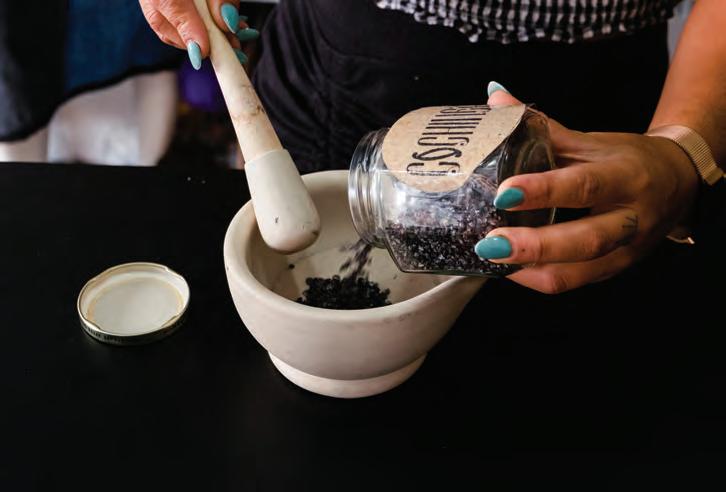
the consumer-friendly United States. Companies have created a perceived need for them to continuously update their wardrobe. Fast fashion consumers tend to value style over durability, according to research by Knošková Ľubica and Garasová Petra from the University of Economics in Bratislava, Slovakia.

Consumers didn’t always shop for clothing this way. “During the Great Depression, most people had no more than five pieces of clothes as a child ... (they) wore the same pair of patched-up overalls for a week straight. Throwing clothes away was unheard of,” wrote fast fashion expert Elizabeth L. Cline in her New York Times best-selling book “Overdressed.”
“Most fashion labels historically produced two main collections:
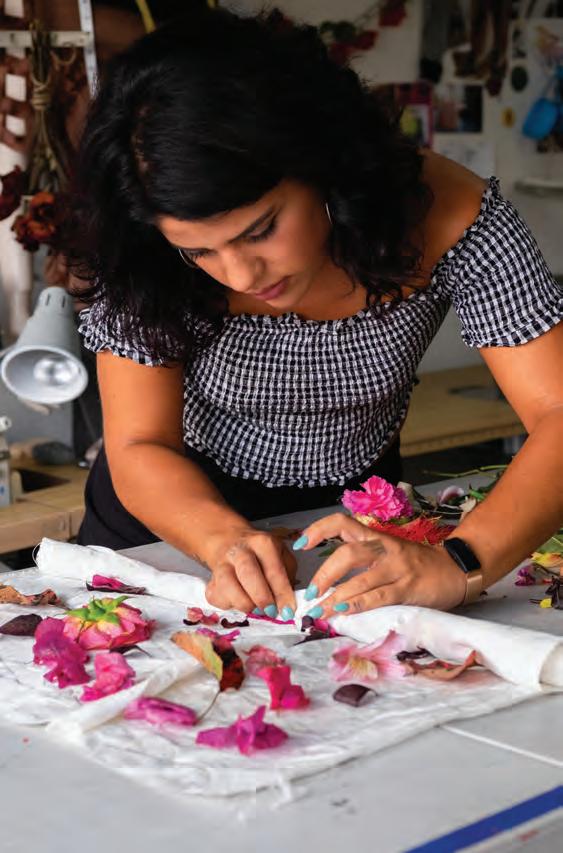
14 Etc Magazine
“Fashion is a way to protest and voice your opinion.”
— Sophia Marie Poulos
Poulos wraps up some meticulously arranged leaves and flowers in preparation for a new batch of naturally dyed fabric. (Emily Trinh/Etc Magazine)
Poulos grinds up cochineal bugs into a powder before boiling it in water to make a dye. No other natural ingredients create red dye as rich and saturated as the cochineal does. (Emily Trinh/Etc Magazine)
Poulos marinates a thrifted white jacket in indigo dye to give it a blue hue. (Emily Trinh/Etc Magazine)
spring/summer and autumn/ winter. A department store had four major selling seasons,” Cline wrote.
Corporations wanted shoppers to buy all year round. As disposable income increased in households across the United States after World War II, big brands found new ways to help people spend their money. “If you only deliver four times a year, there’s only a reason to come to the store four times a year,” said JC Penney Chief Executive Officer Myron E. Ullman III in a 2010 Wall Street Journal article.
To keep customers shopping, fashion brands began to churn out new designs for cheap and generate demand by outfitting celebrities as walking advertisements. When former First Lady Michelle Obama wore a $35 Jason Wu dress from Target during a trip to Florida to promote her Let’s Move! campaign in 2012, the dress sold out online and in most Target stores within hours. Similarly, a $59 Sherpa
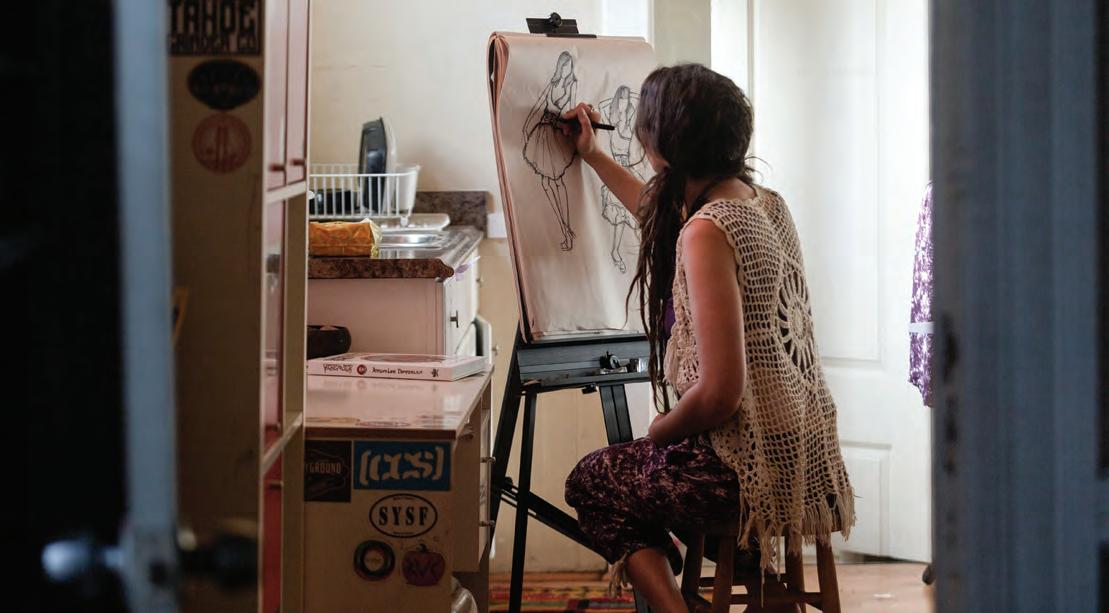
Trucker jacket from American Eagle ran out of stock after Selena Gomez was spotted wearing it in 2019.
Clothing today can be so inexpensive that the money spent on it feels inconsequential, even for people on tight budgets. At $4.95 a piece, one can rock the latest Hollywood look for the price of a Starbucks frappuccino. But fast fashion is consequential because of its impact on the environment.
“When you’re wearing synthetic fabrics, which are most often used to make fast fashion items since they keep costs low, you’re actually wearing plastic clothing that never breaks down,” says Lambert.
As an alternative, Lambert advocates for hemp fabric, which she claims is better than cotton. It’s cheap, fast and easy to grow.
Hemp production uses 50% less water than cotton, doesn’t require pesticides and isn’t invasive, according to Lambert.
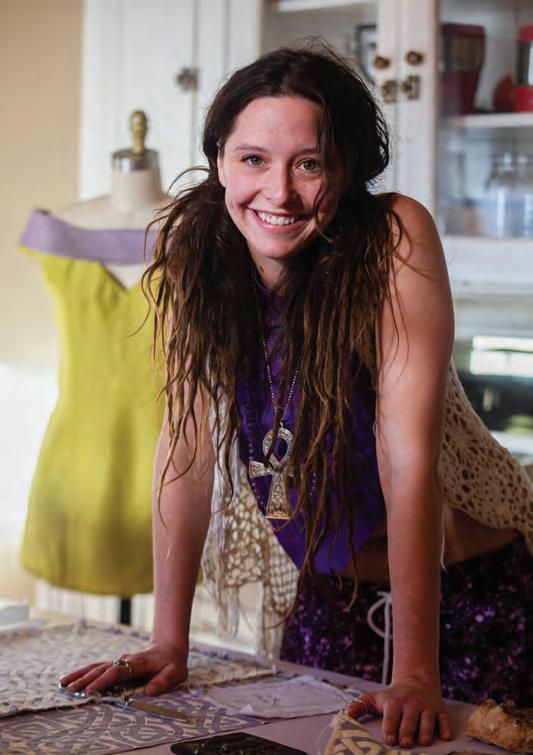 Designer Laura Lambert works on her sketches in her kitchen in Emeryville, California. The kitchen doubles as her her fashion studio. (Kevin Kelleher/Etc Magazine)
Designer Laura Lambert works on her sketches in her kitchen in Emeryville, California. The kitchen doubles as her her fashion studio. (Kevin Kelleher/Etc Magazine)
Fall 2020 15
Lambert stands in front of a hemp design which was part of a collection she made while at City College. (Kevin Kelleher/Etc Magazine)
is strong and extremely versatile. It can be used to make paper, plastics, paint, biofuel and food in addition to clothing.
For over a century, hemp has been stigmatized alongside its sister plant cannabis. They look very similar to the untrained eye, but unlike cannabis, you cannot get
high from hemp.

Newspaper tycoon William Randolph Hearst saw hemp as competition to his paper business in the early 1900s. In addition to owning the largest newspaper company at the time, Hearst profited off of many acres of forest that were used to create and supply paper to his publications.
Using their similarity in appearance, he demonized hemp alongside cannabis by promoting the idea that both were extremely dangerous drugs that would drive Black and Mexican men to rape and kill white women.
He was not alone. Pierre Samuel du Pont, founder of the DuPont Chemical company,
16 Etc Magazine
Ursula Bahamondes models one of Poulos’ sustainable designs. The prints on her blouse are the results of Poulos’ dyeing process in which she uses flowers, leaves, and vinegar. (Kevin Hemp fiber
vinegar. (Kevin Kelleher/Etc Magazine) was heavily invested in synthetic fibers at the time and did not want hemp fibers to eat into his revenue either.
Their smear campaign worked and now hemp fabric is expensive. “It’s only available for purchase through China and you have to pay tariffs,” Lambert explains. Currently, China controls the market.
Even with the passing of the 2018 Farm Bill, which legalized hemp production in the United States, hemp fabric is still not available at a price point where it can compete with materials used in fast fashion. “We can farm the plant here but we don’t have the infrastructure to turn it into fabric at a commercial scale yet,” Lambert says.
This is one example of why conscious fashion choices remain more expensive and inaccessible than fast fashion. Even so, there are still ways to be sustainably stylish without spending an arm and a leg.
Sophia Marie Poulos is a City College fashion design graduate who specializes in natural fabric dyeing and upcycling, the repurposing of pre-owned clothes.
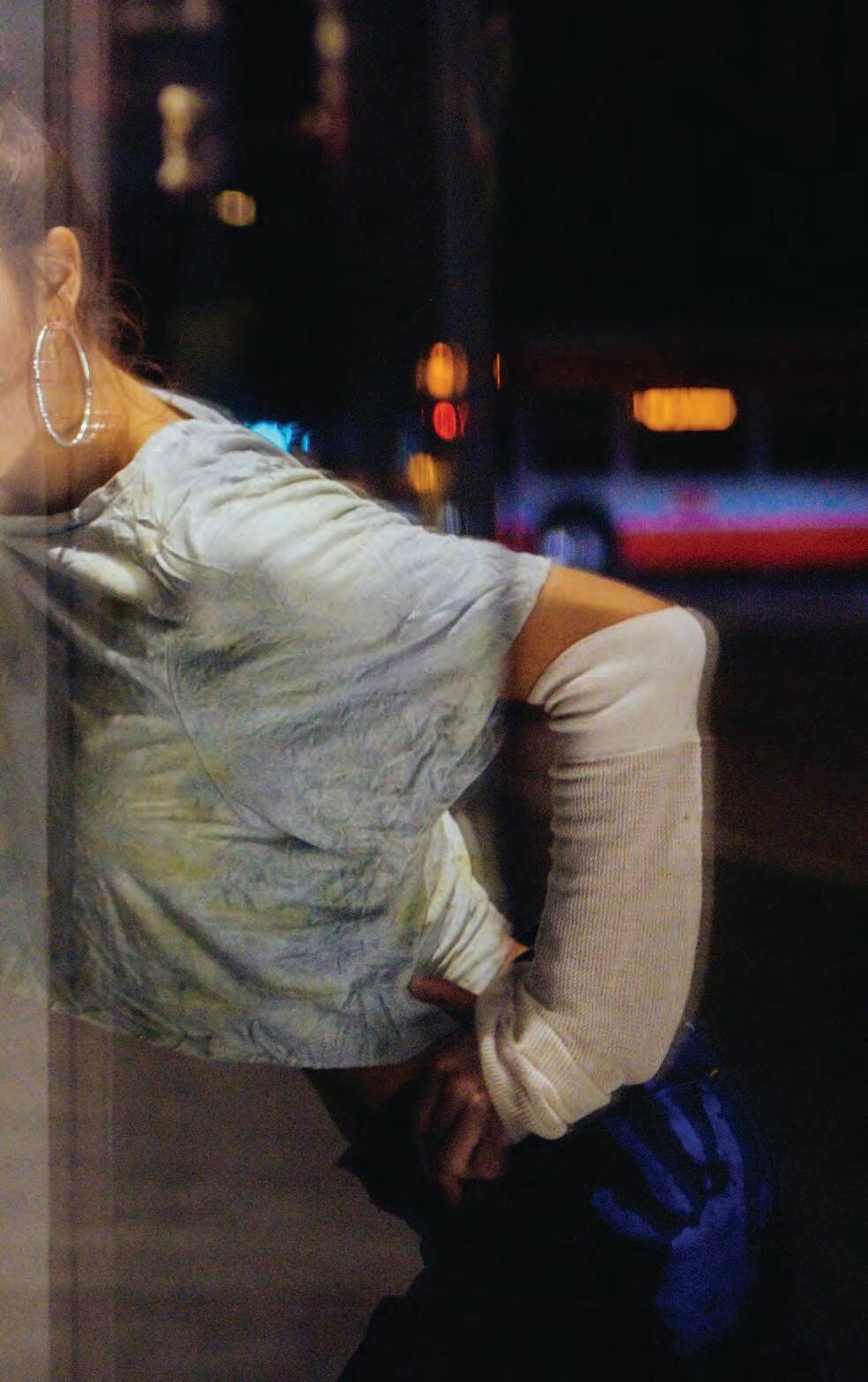
Poulos began her sustainable fashion journey by reconstructing her old clothes and before she knew it, found herself with a collection of upcycled outfits. She shared them online, launching her sustainable brand called IconaWear. A month later Poulos was invited to show her work at San Francisco Sustainable Fashion Week.
Poulos strives to make every step of her creative process sustainable. “I use Trader Joe’s paper bags to make sewing patterns,” she says, pulling out a stack of brown bags from underneath her desk. In front of her, the wall is covered with posters and images that inspire her creations. One of them says, “Fuck the system.”
“Fashion is a way to protest and voice your opinion,” Poulos says about her fashion philosophy. “You are a walking billboard for whatever you believe.”
She dyes fabrics using indigo, cochineal, and other natural ingredients. “I found these around my block,” says Poulos as she meticulously arranges leaves and flowers
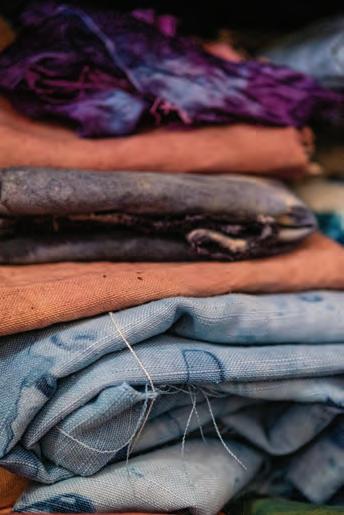
Fall 2020 17
A stack of naturally dyed fabric piles up inside Poulos’ cabinet, ready to be transformed into clothing. (Emily Trinh/Etc Magazine)
on a white t-shirt she found at Goodwill. She sprays on vinegar and rolls the shirt up tightly before steaming it over boiling water. This process transfers the colors and patterns of the flowers and leaves onto the fabric.

Poulos grew up in the fashion industry. Her mother was a hair stylist for runway shows in San Francisco and together they opened a jewelry company before Poulos enrolled at City College.
Now she operates her own Etsy store where she sells upcycled clothes while taking online classes at the Academy of Art. She has an Instagram account @sophia.marie where she makes educating
her audience about sustainable fashion engaging and fun.
Lambert and Poulos, friends from their days at City College, agree that education is a key factor in promoting sustainable fashion. Lambert wants to eliminate the stereotype that whoever wears hemp clothing is a marijuana-smoking hippie.
“We need to show people that they can have really cool and stylish clothes,” Lambert says, “without looking like they just walked out of a head shop,” which historically was the only place to buy
“New generations of consumers care about the environment and will demand sustainability from the brands they’re buying from,” Lambert says.
Dixit also sees the change and believes “secondhand clothing, recycling and upcycling are the future of fashion.”
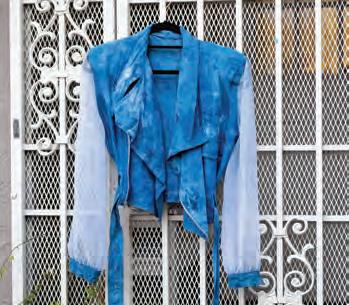
Her whole perspective shifted during the pandemic. She now sees “how content and happy we all can be with limited resources … Just like we eat organic food since it’s good for our body and our environment,
hemp clothing.
Lambert thinks the fashion industry is on the cutting edge of a new era. “All of the 2021-22 projected trends are centered around sustainability,” she says quoting the World’s Global Style Network, WGSN, the fashion forecasting company and current industry standard on consumer and design trends.
sustainable clothing should also be a part of our lifestyle.”
Now when Dixit shops, she prefers quality over quantity, and will pay more for items that last. She consumes less and cares more about where her clothes come from and how they are made. She thinks twice before swiping a card for that $5 H&M t-shirt.
18 Etc Magazine
“New generations of consumers care about the environment and will demand sustainability from brands they’re buying from.” — Laura Lambert
This fabric is a result of Poulos’s dyeing processs in which she uses vinegar infused steamed leaves and flowers. Poulos uses all natural materials and upcycling, which is the reuse of old fabric, to make her fashion sustainable. (Emily Trinh/Etc Magazine)
Poulos dyed this jacket with indigo after buying it from Goodwill. (Emily Trinh/Etc Magazine)
OFF THE GRIDIRON INTO THE ZOOM
With football season postponed, the Rams charge into unknown territory
Story by Charles Butler
Illustrations by Bobby Ramirez
It’s Monday morning and Jimmy Collins is at home going through texts and emails that have been backed up since Friday. In a typical October, Collins, who is going into his 11th year coaching the Rams football team and his fifth as head coach, would be preparing for the first practice of the week. But with fall sports postponed due to COVID-19, he is instead preparing for a 4:00 p.m. Zoom meeting.
When the California Community College Athletic Association made the decision to postpone the fall football season until Spring 2021, life changed for every member of the team, including the coaching staff.
It was an unfortunate setback, particularly for the players who depend on their time at City College of San Francisco to develop their athletic skills and increase their on-field experience before moving on to more competitive leagues at four-year schools.

But Collins and his team are not letting the circumstances ruin their chances to improve over the fall semester. After all, these student athletes chose City College not only to play football, but to develop academically and to become better people.

“Mark my words, five years from now this is going to be the
most important thing that’s ever happened to the team, and that’s how we’re going about it,” says Collins when asked about this forced time off.
Rams coaches and staff, aware of the lost bonding opportunities, still want their players to build a team community even though time on the field has ground to a halt.
They stay connected on Twitter. Using the hashtag, #noplacelikecity, players share each other’s highlight tapes, congratulate teammates when they receive Division I offers and even post their home workout videos.
Coaches encourage players to use this time to build new connections within the team. In most football programs around the country players work primarily with their position coaches; wide receivers talk to the wide receiver coach, linebackers talk to the linebacker coach, and so on.
Fall 2020 19
Rams linebacker Dino Kahaulelio works out without his teammates during the pandemic at a practice field in Santa Rosa, Calif. (Kevin Kelleher/Etc Magazine)
This season, each coach is assigned a new group of players from different positions every two weeks and the rotating groups meet through video conferencing. “It’s great because I’m able to build relationships with players that I never would
have (gotten to know) before,” says offensive line coach Eduardo Nuño.
“We get together on Tuesdays via Zoom, then individually the players call each other and ask about 10 questions,” Nuño says. At the end of the week they present their answers to the rest of the team about their teammate. “It’s been a great way for us to come together without actually being together.”
This sense of community extends generationally, beyond the current team and coaches. Several players hope to continue a legacy of City College national championships. Sophomore running back Anthony “Speedy” Heard Jr.’s father Anthony Heard Sr. was a part of the Rams’ 1994 national championship team. Unable to work out with his teammates, Heard Jr. and his father work out together.
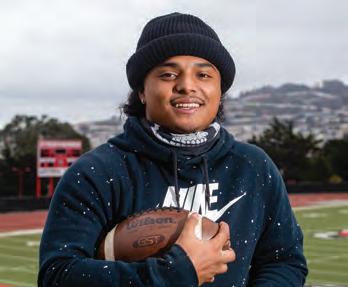
“We are going to prove that we have been outworking our opponents and living up to the expectation of winning a national title,” Heard Jr. says.
Freshman running back Jalen Camp follows in the footsteps of his brother Vince Camp, a member of City College’s 2015 national championship team.
Like many college athletes, Jalen Camp has played multiple sports since elementary school. “I’ve been playing football, basketball, and running track since I was seven years old.”
Ultimately Camp chose football over track and basketball. “I wanted to be great, and that meant going all in on my dream. I knew that if I worked my tail off, I could go to the NFL,” he says.
With more time on their hands, the football team’s grades are much improved this semester and with better grades, more schools will show interest — eligibility to play depends on grades.
“This is the type of situation that tests what type of person you are. We wish that we could play ball, but what we can do is have our grades right,” Heard Jr. says.

20 Etc Magazine
“This is the type of situation that tests what type of person you are. We wish that we could play ball, but what we can do is have our grades right.”
— Anthony Heard Jr.
Rams Head Coach Jimmy Collins sits for a portrait in the bleachers of the George M. Rush Stadium on City College’s Ocean Campus where the Rams would normally play. (Emily Trinh/Etc Magazine)
Rams running back, Anthony Heard Jr., poses above the George M. Rush Stadium during the global pandemic. (Kevin Kelleher/Etc Magazine)
Kahaulelio sprints during his workout. (Kevin Kelleher/Etc Magazine)

Academic Counselor for Athletics Katie Marquez also considers this moment a silver lining. “Athletes have to work so hard at their skill on the field, that their academics unfortunately tend to take a back seat,” she says. “That is what’s making this offseason different from any other.”
She is pleased to see the athletes take full advantage of their additional offfield time. It will save athletes time and money in the long run.
“The football season being postponed is out of our control. What we can control is where we spend our time, thoughts and energy,” says strength and conditioning coach Abe Munayer. “We don’t have access to the future, only to the present moment. This is where we are given the opportunity to get better.”
It’s no easy task to chase dreams like going pro or playing at a competitive four-year school. In a typical season, players balance the equivalent of two full-time jobs: a rigorous academic
course load each semester in order to qualify for the season, plus the time they dedicate each week to their sport. This does not include part-time jobs that, for some players, decide if food is on their table. It’s a balancing act.
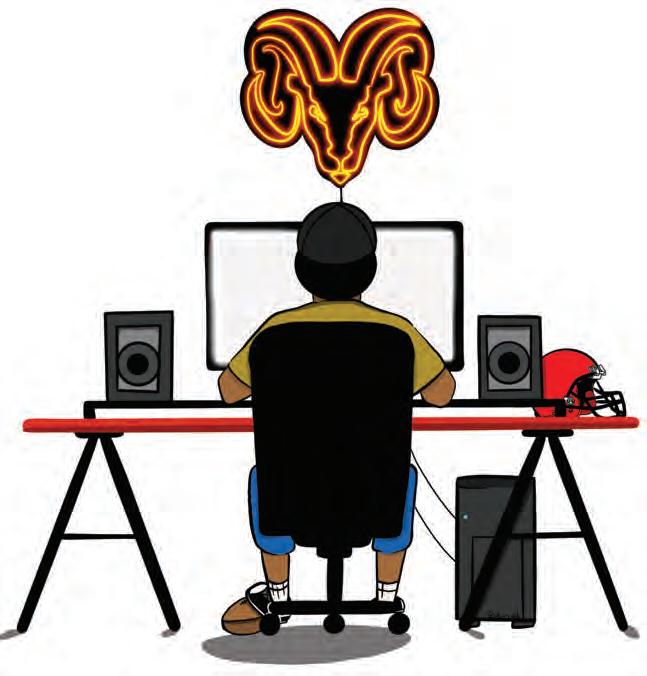
With more time on their hands, players are taking on more classes and getting closer to completing their associates’ degrees. “This is the first period of my life where I’m not playing a sport; it’s weird, but it’s helped my academics a lot. I’m enrolled in 10 classes and I’m not just getting by, I’m somewhat excelling,” sophomore defensive end and linebacker Dino Kahaulelio says.
Community college is a pathway for players that want to transfer but need to improve their academics first. “These kids have actually gained some leverage outside of football. They are
Fall 2020 21
getting a semester’s worth of education and time, without losing any eligibility. They’re saving money by being able to take these courses at CCSF instead of when they transfer to a four-year university,” Marquez says.

Camp also sees the bigger picture. “I’m going to make it all the way, and in order to do that I have to put the work in. I’m a fulltime student athlete.”
Every week this fall semester, players have been grinding it out in their studies hoping to be named the team’s “student of the week.” To win, a player must have straight A’s, and athletes love competition. Not only are players getting A’s, many of them have 95-100% averages in their classes.
Coach Collins is impressed and proud. “The overall team is doing so well that there is still a list of players who are projected to make the Dean’s list at the end of the semester, but haven’t been named student of the week due to it being so crowded at the top.”
Come spring, the Rams expect an eight-game season, then a quick turnaround back into the following fall season. Players can only hope no one gets sick or injured and games aren’t canceled. “We came here to win,” says Heard Jr.
The Rams’ opportunity to play ball may be gone for now, but in the meantime they are preparing. When the time comes to return to the field, they will be more than ready.
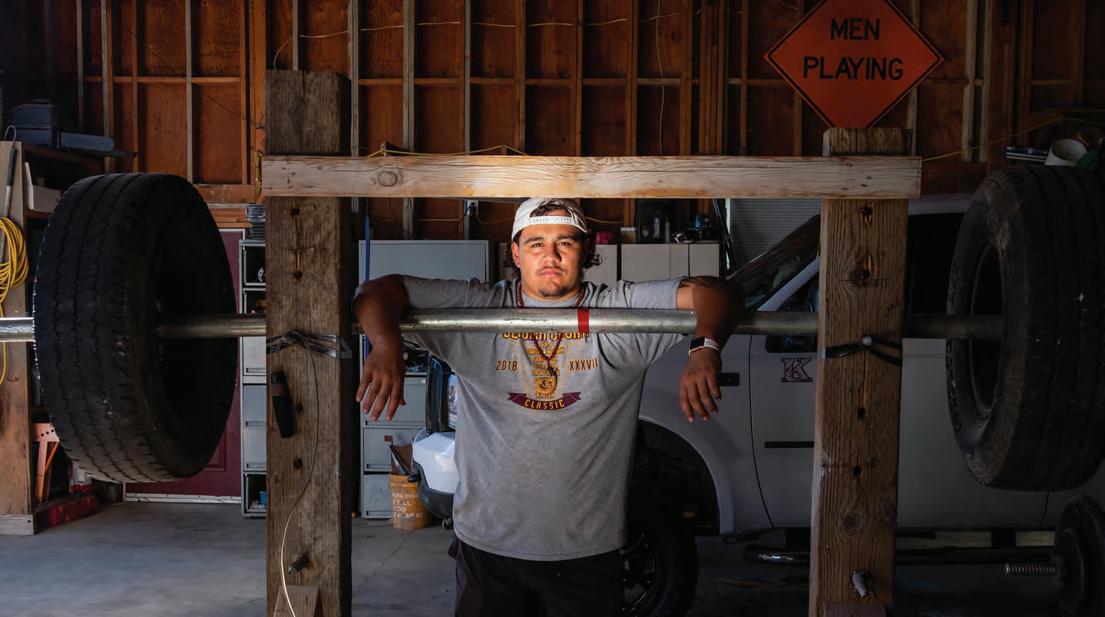
“The football season being postponed is out of our control. What we can control is where we spend our time, thoughts and energy.”
— Abe Munayer
Kahaulelio poses in his garage home-gym where he works out since he cannot access the gym at City College during th epandemic. (Emily Trinh/Etc Magazine)
22 Etc Magazine
George M. Rush Stadium appears deserted after the City’s shelter-in-place order. San Francisco, California. April 18, 2020. (Kevin Kelleher/Etc.Magazine)
IT
TAKES
A VILLAGE
Third Parent Family feeds more than bellies during the pandemic
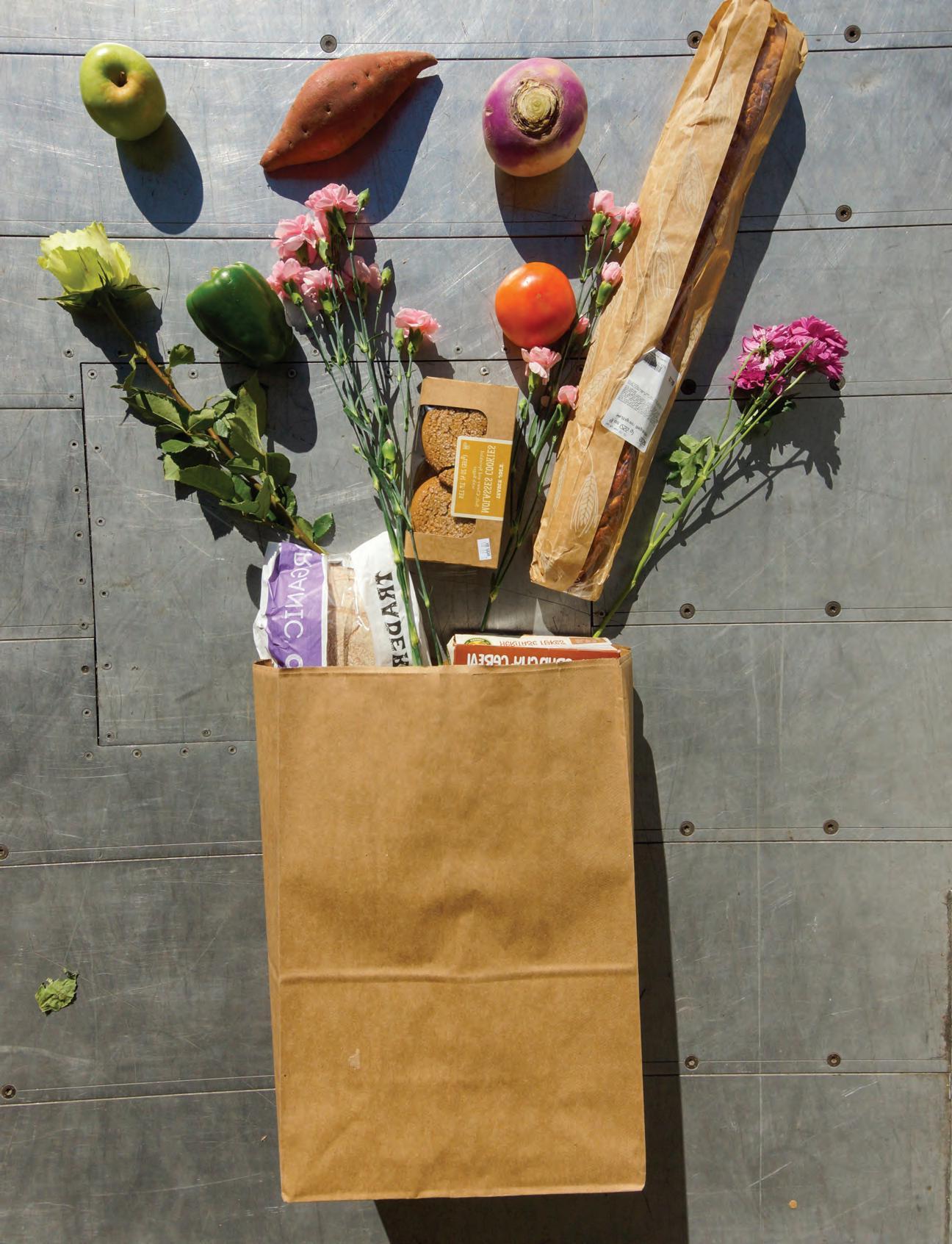 Story and Photographs by Bo Lenschau
Photo illustration of a Third Parent Family grocery distribution.
Story and Photographs by Bo Lenschau
Photo illustration of a Third Parent Family grocery distribution.
Daveea Whitmire finishes loading up a U-Haul with the last of 130 brown paper bags filled with groceries. They are destined for the pop-up food delivery program that was kicked off in April by the fledgling nonprofit, Third Parent Family, TPF. The groceries will head to neighborhoods all over San Francisco, Oakland and Berkeley for distribution to families that TPF has identified as in-need.
Whitmire and his partner Whitney White founded TPF as a client-centered case management nonprofit in December 2019. Client-centered case management means they tailor aid to fit each individual’s needs. “The patient is the expert of their own body. Everyone is built differently, with similar situations but distinct circumstances,” Whitmire says.
The name Third Parent Family came from Whitmire’s idea that having a third parent would have been beneficial for him growing up. TPF hopes to fill that role for people in their community.
TPF’s first initiative focused on assisting clients in the process of obtaining drivers’ licenses which in turn, creates more job possibilities.
“We know that a barrier for some folks is not having a car to take a test in, or having access to one. Our goal is to break societal barriers by offering resources. This resource was crucial in our community,” says White.
Whitmire and White used their personal savings to start the organization. Then they received a $10,000 grant from the San Francisco Foundation to be put towards administrative needs and their food initiative.

When the pandemic hit in March, they funnelled most of their funds towards food distribution. Every Saturday since April, TPF provides bags of nutritious food for struggling families who are just trying to get through the week.

“We knew how much the community we were serving needed the supplies and support,” says White.
The organization identifies its clients by contacting the community recreation centers of Bay Area neighborhoods. This enables them to reach diverse groups of people in need. The organization also does outreach through social media and provides information about their program on
their website. Volunteers are available at the pop-up food banks to answer any questions or help potential clients connect with TPF.
Whitmire and White’s team of around 20 dedicated volunteers are at the core of TPF’s success. “Our volunteers are the backbone of our organization. Our volunteers bring their uniqueness and expertise to TPF and share it,” says Whitmire.
Many of the volunteers learned about TPF by word of mouth or by inquiring at a pop-up food bank.
“We have roles that need to be filled on a weekly basis, but our volunteers do more,” says White.
Luccia NoëlJungclaussen, 14, has been helping out with the weekly food deliveries for almost five months. “The people here are like friends and really almost family because we see them so regularly and by now, we actually know them really well,” she says.
Week after week NoëlJungclaussen sorts the donated food items into bags and helps distribute them. When TPF hosted a turkey giveaway this past Thanksgiving, she assisted in designing posters and flyers for the event.
Like Noël-Jungclaussen, Whitmire and White have always had an affinity for community service.
White, 31, grew up in Brooklyn, went to high school in New Hampshire and received a Bachelor of Arts from Loyola University in Maryland.
As a high school student, White was part of a program called Brewster Big Friends, a student club that paired students from different age groups to provide a big brother or big sister relationship to younger
“It was something where you could immediately see your impact and where you made a difference,” says White.
Inspired by her mother, who was a kindergarten teacher, she began teaching for the San Francisco Unified School District in 2016.
Whitmire, 35, grew up in San Francisco and graduated from the community healthwork program at City College of
24 Etc Magazine
Third Parent Family, TPF volunteer Riley Dunkle carries two packages of donated groceries to be put into brown paper bags for distribution
Lucia Noël-Jungclaussen writes a motivational quote on a sticky note that will later be distributed with TPF’s grocery bags. children in the community.
“I can remember as far back as 12, being involved in programs at the Third Baptist Church of San Francisco. Their Friday Night Live youth program made me feel as if I had a greater sense of community,” says Whitmire.
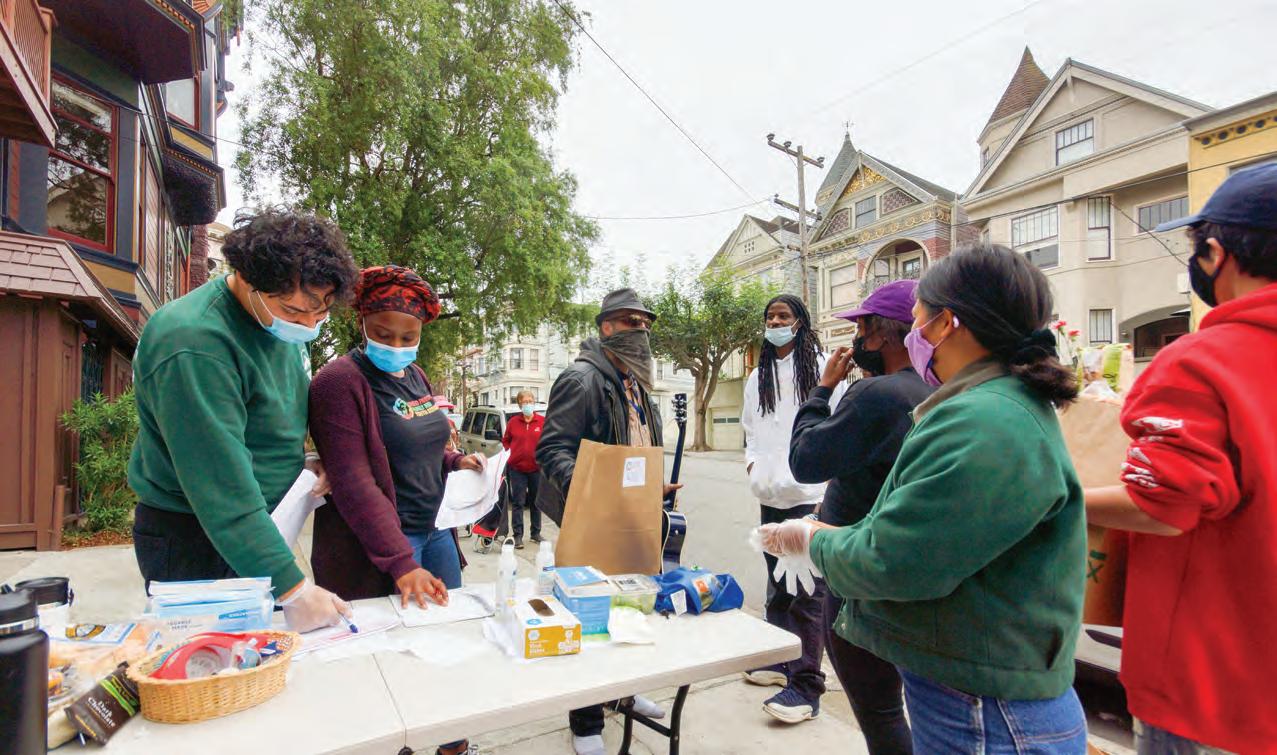
Whitmire worked in San Francisco’s juvenile hall, teaching incarcerated youth about HIV prevention. Despite his accomplishments in the field of restorative justice, Whitmire grew frustrated with what he saw. He was shocked to find out many of his students were still unable to read.
“With my clients I wanted to do everything I could; hook them up with jobs and help them get on their feet, but the organization wasn’t equipped with everything I needed,” says Whitmire.
He and White met in 2015 at the Haight Street Fair. Whitmire, whose rapper name is “Self Thuggah,” has been active in the Bay Area music scene for over 10 years. He was filming a music video and struck up a conversation with White during a break in filming, and the two immediately hit it off. They dated long-distance for a short time before White moved out to San
Francisco. “I needed some change in my life,” says White.
By 2019, with years of education and public service experience under their belts, White and Whitmire felt that starting their own nonprofit would allow them to have a more direct impact on the community.
TPF’s mission is multipronged: to provide food, shelter and healthcare resources, but for now food distribution is the top priority.
According to a recent analysis by Feeding America, a nonprofit organization that is a nationwide network of more than 200 food banks, the COVID-19 pandemic has the potential to drive an additional 17.1 million Americans into food insecurity, many for the first time. This represents a 46% increase from the 37 million who were food insecure prior to the pandemic.
In California alone, 6,362,000 people are projected to face hunger this year — an increase of about two million people from 2019.
Thanks to donations from supermarket chains like Trader Joe’s and Sprouts Farmers Market and from local organizations such as Bay Area Rescue Mission and Haight-Ashbury Food Program, TPF volunteers are able to fill the bags weekly with a variety of fresh food items for a balanced and healthy diet.
Recipients get more than food each week, too. Volunteers place flowers inside and attach sticky-notes with motivational quotes and affirmations to every bag.

Fall 2020 25
Flor Polanco receives her package of groceries from TPF. The packages are tailored to fit beneficiaries’ diverse needs and dietary restrictions.
From left to right, Fernando Ansaldo-Sanchez and Rudairo Segbeaya plan delivery routes for a distribution run while Daveea Whitmire, Whitney White, Jaira Roxas and Dexter Shen welcome and enroll a new TPF recipient into their food delivery program. San Francisco. Through the program he received certificates in both youth and post prison advocacy.
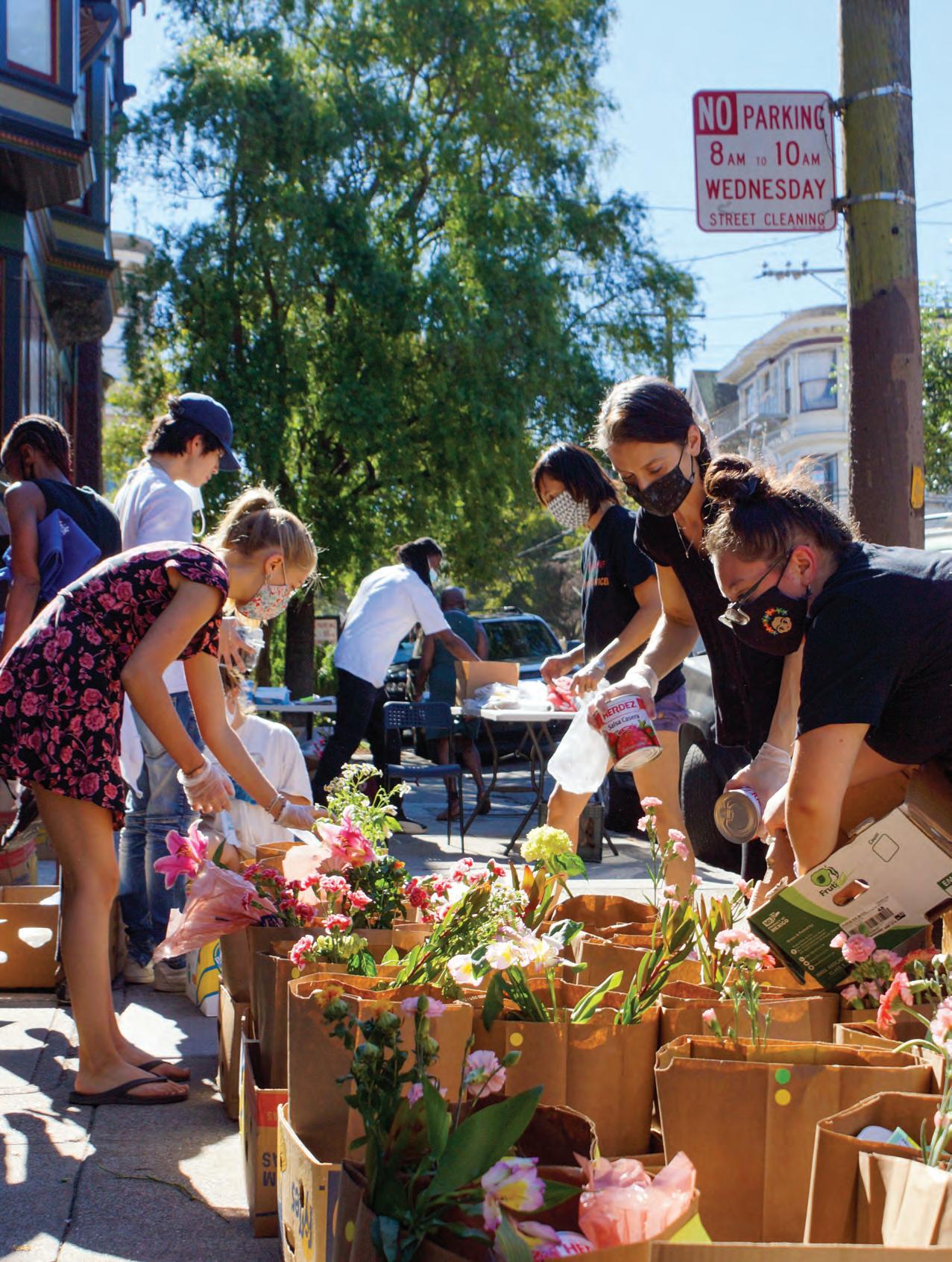
“Receiving groceries from TPF is like Christmas every week,” says Monica Espinoza, a mother and single parent who lives with her elderly parents and has been a beneficiary for about four months. “The flowers we get each week are such a special touch. It makes my living room smell wonderful,” Espinoza says.
As the nonprofit grows, Whitmire and White hope to initiate programs that provide affordable housing placement and job development. They envision TPF as a platform where volunteers can mentor and support clients with career services as well as other types of aid.

In addition to donations, Whitmire and White still spend their personal savings and income to keep TPF afloat. White works as an educational consultant, and Whitmire receives royalties from his rap career.
“I have always loved the community,” says

White. “Where I am from, the model ‘it takes a village to raise a child’ stood true. Our families stepped up and took care of each other. This followed me as I grew up.”
“TPF is truly a family in every sense of the word. As we meet volunteers and they begin to come and help out, relationships grow organically. We like people to flourish,” White adds.
Every Saturday, volunteer Antoinette Lewis helps set up the pop-up TPF food bank on the sidewalk in front of her house in Haight-Ashbury. Known as “Auntie” to the rest of the volunteers, she makes her basement available as a storage room for tables, bags and chairs and remains available by cell phone as a contact person for certain beneficiaries.
Sitting on the steps outside of her Victorian home one Saturday, Lewis points down to her left ankle to reveal an anklet she received as a gift. “This girl, her name
is Lisa, she gave me this a couple days ago. She stopped me on the street. She said, ‘You know what? You helped me live!’” says Lewis. “And now she’s got her own house, baby, and she’s living really good. She bought this for me and said, ‘I wanted to get you something because you really helped me get to who I am.’ And yea that’s what Third Parent is. That’s what it is to me.”
Fall 2020 27
“We like people to flourish.”
— Whitney White
Above: Whitney White, left, and Daveea Whitmire, right, sit with their son Daveea Whitmire Jr, one, center, in the back of a U-Haul used to carry food donations to a TPF pop-up food bank location. Left: TPF volunteers fill up grocery bags before distribution.In addition to an inspirational sticky-note, each bag gets fresh flowers.
Antoinette Lewis known as “Auntie” to the rest of the TPF volunteers, sits on the front porch of her house in Haight-Ashbury, San Francisco.
NO MORE SILENCE.
Project SURVIVE dismantles rape culture through the power of education and community
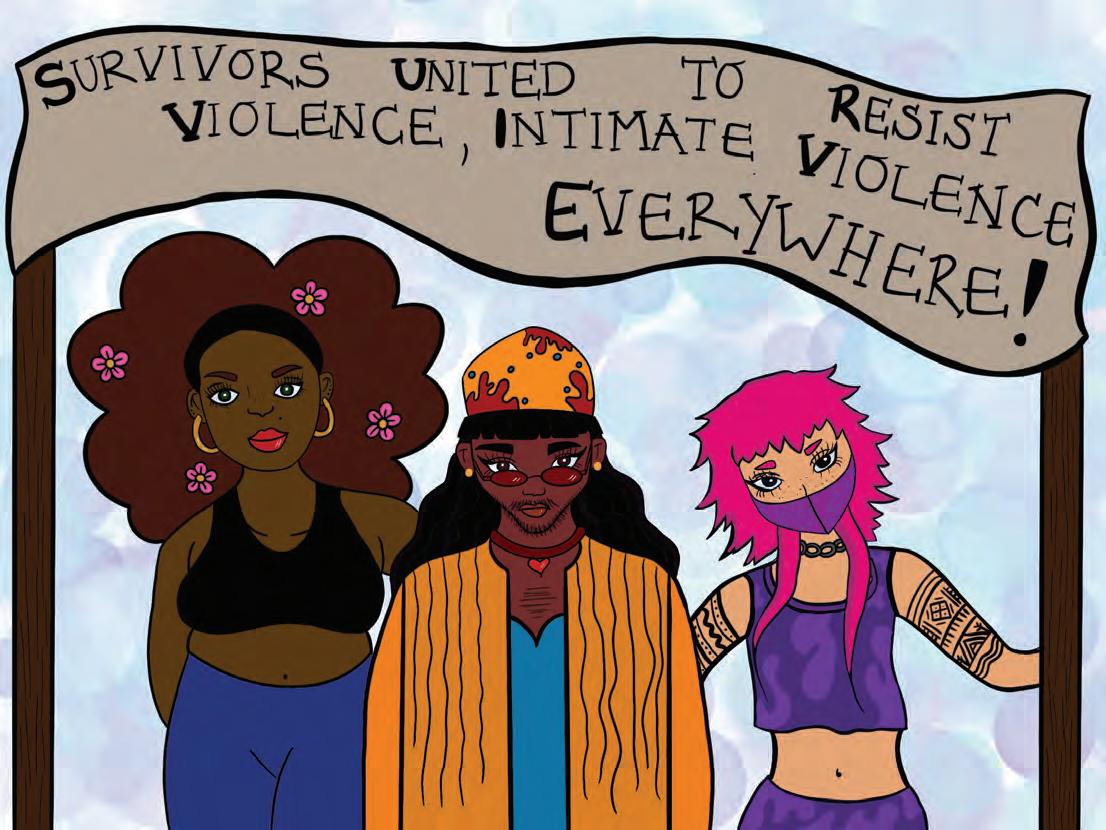
Pinned to the wall outside of Project SURVIVE’s office in City College of San Francisco’s Cloud Hall, photos depict smiling students and peer educators. Below the photos, stacks of pamphlets recommend resources and centers for people who need them. Inside the office, Adele Failes-Carpenter, the current coordinator of Project SURVIVE, which stands for Survivors Unite to Resist Violence, Intimate Violence Everywhere, sits at her desk to review this week’s work schedule for the program’s peer educators.
Project SURVIVE is a peer-led sexual violence and healthy relationship program that educates City College students on topics that range from demystifying misconceptions about rape and rape culture to identifying signs of abuse.
According to the Rape, Abuse and Incest National Network for every 1,000 rapes, 384 are reported to the police, 57 result in an arrest and 11 are referred for prosecution. Only seven result in a
Story and Illustrations
28 Etc Magazine
by Jennifer Yin
NO MORE VIOLENCE.
felony conviction and a mere six out of a thousand result in incarceration.
The Centers for Disease Control and Prevention, CDC, reported that at least one in seven children in the United States experienced child abuse and/or neglect in 2018 alone, killing nearly 1,770 children. Rates of child abuse are five times higher for children in families of low socioeconomic status. Programs like Project SURVIVE aim to reduce these statistics by working directly with vulnerable populations.
Project SURVIVE was founded in 1993 by Leslie Simon, an instructor for the women and gender studies department. During the organization’s first year, Simon and the program’s first peer educator, student Patty Zevallos together completed approximately 60 presentations. Nowadays, Project SURVIVE’s 11 trained peer educators are able to do an estimated 400 presentations each academic year.
To become a paid peer educator, one must complete or be concurrently enrolled in Women’s and Gender Studies, WGST 54: Politics of Sexual Violence and WGST 55: Ending Sexual Violence. After completing the courses, peer educators can be hired by the college as either a lab aide or through a federal work-study program. Enrolled students also have the opportunity to obtain their sexual health educator certificate. There are scholarships available for undocumented students, who want to make contributions as peer educators but cannot be paid through the other two avenues.
Some peer educators are survivors of sexual violence themselves and find the Project SURVIVE community to be a safe haven for their own healing and growth. Faith Fabiani became a peer educator as a way to separate herself from a controlling and abusive relationship in her past. “I felt like I had no one,” says Fabiani, who had to isolate from her community in order to escape her abuser.
She attributes her turnaround to Project SURVIVE and Simon’s classes. “I’d probably be dead, still on the streets or in prison,” Fabiani says. “I needed to feel welcomed and at home.”
Another peer educator Peter Piñon was sexually molested at the age of 14. Reliving his experiences during legal proceedings 10 years later was traumatizing.
“I found it very hard because I was raised in the Monterey area, so it’s a small community. Everybody knew about the whole thing. My friends knew and my family knew ... He was a baseball coach and he was loved by the families,” Piñon says.

Piñon’s case is an example of the breakdown of social power. The perpetrator’s higher standing within the community gave him more social power compared to Piñon. This imbalance ultimately resulted in a hung jury, meaning the jurors couldn’t come to a verdict.
Social power is a key component of the teachings of the peer educators. Project SURVIVE defines social power as anyone who is in a place or position to abuse others.
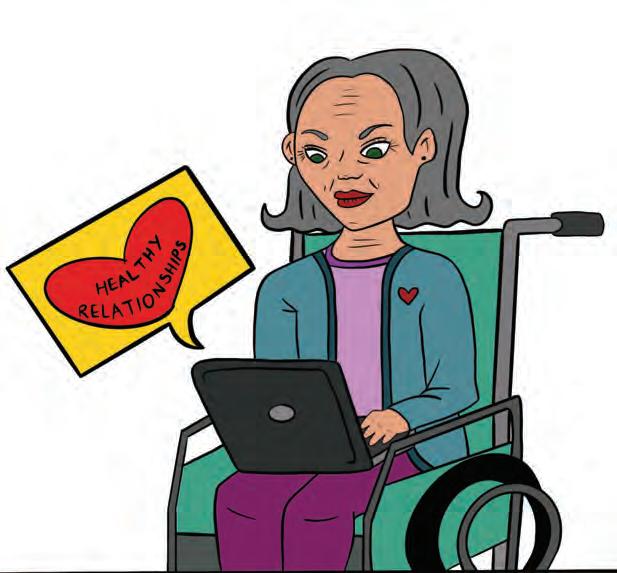
In 2006, Simon, with the help of Project SURVIVE’s peer educators, created the program, Expect Respect SF. Designed for high school students, this program is now taught in all public institutions within the San Francisco Unified School District.
Peer educator Veronica Fulbright worries for the children who won’t receive sexual education. “A lot of younger kids unfortunately have probably suffered from sexual and domestic violence,” she says. “I definitely worry because if you’re not getting this awareness then you’re not going to ever know that there’s things out here to help you.”
Project SURVIVE helps educate the City College community
“I can’t be running anymore. I am going to do this for people that weren’t believed. I’m going to do this for people that don’t have a voice.”
Fall 2020 29
— Peter Piñon
through presentations. Peer educators will go into a variety of different classes and give a quick lecture on sexual violence, abuse and prevention. The intention of the presentations is to have a conversation with student audiences.
Peer educators stress to students that rape is nobody’s fault but the abuser’s. They discuss how rape can affect anyone no matter their race, sexuality, ethnicity, demographics or income. During presentations, they share and debunk rape myths from Project SURVIVE’s “Your Guide to Healthy Relationships” handbook.
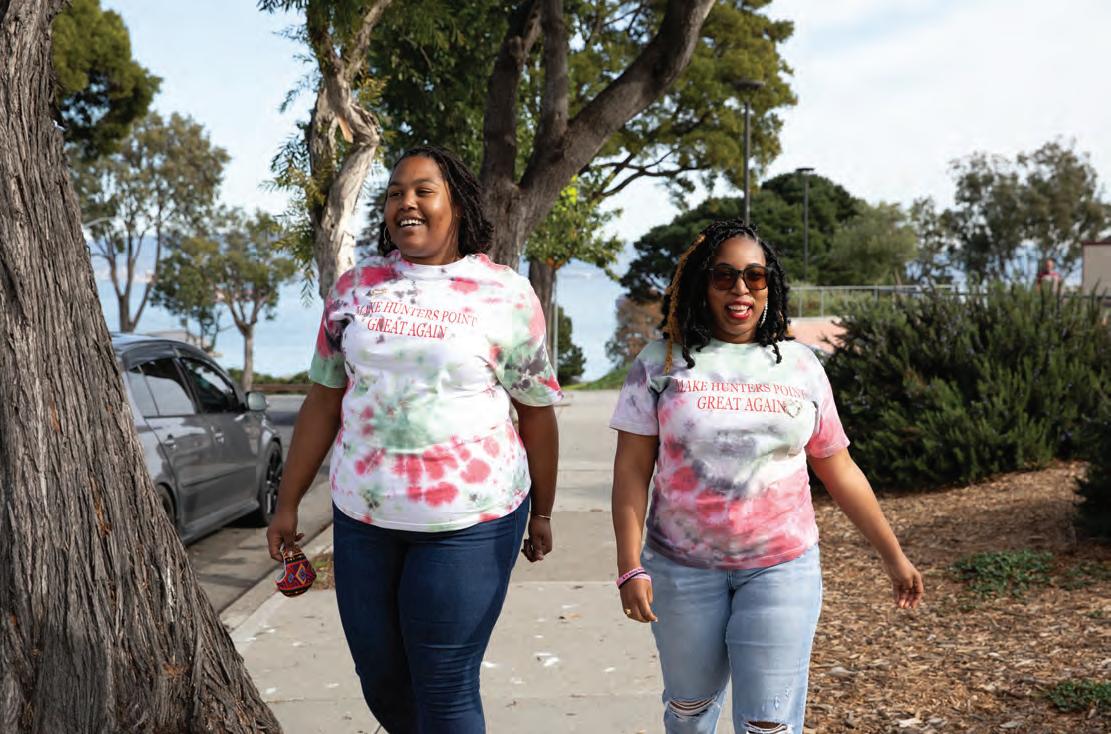
Presenters make a point to discuss the specifics of date rape too. Peer educators, like Dale Smith and Taylor Strommel, role play in an exercise called “Pat and Chris,” to teach students about risk reduction before and during a date.
Since the pandemic, Project SURVIVE has transitioned from in-person to online presentations via Zoom. The online version consists of two peer educators, one tech moderator and Failes-Carpenter as host.
Students tune in remotely to see a red glowing heart appear on the middle of their screen. Etched in the center are the words “Healthy Relationship.” Then
students are asked to brainstorm for phrases that describe what they seek in a healthy relationship: mutual respect, loyalty, healthy arguments, boundaries,

30 Etc Magazine
Coordinator Adele Failes-Carpenter sits in Project SURVIVE’s office in City College’s Cloud Hall, on Ocean Campus where she regularly meets with the peer educators. (Jennifer Yin/Etc Magazine)
Childhood friends, Rahsandrea Johnson. left, and Veronica Fulbright, right, walk around the Bayview district wearing shirts advocating for social justice. Johnson, a City College alum, is a graduate of Project SURVIVE. The two women hope to start their own eduction program titled, “Healing Hearts.” (Melvin Wong/Etc Magazine)
acceptance. The goal of the brainstorm is to teach students that they each deserve to be treated with respect by their partners.
Over 100,000 students have benefited from these presentations. That’s 100,000 students in potentially healthier relationships. When the accreditation crisis hit in 2013, the school sought to cut down the program, but Project SURVIVE used their headcount to persuade the administration that the program was effective and worth continuing to fund.
Now COVID-19 and the resulting campus-wide closure coupled with City College’s ongoing financial crisis means Project SURVIVE, along with many other departments, must get creative to keep its peer educators compensated.
Currently FailesCarpenter only has a lab aide budget for the fall, and is requesting funds for the spring semester. She is supplementing the lab aide award with federal work study funds.
Meanwhile, the need for support programs like Project SURVIVE is only increasing while students are sheltering in place. According to the Substance Abuse and Mental Health Services Administration’s website, “Major economic devastation disconnects people from resources and support systems. Such conditions may stimulate violence in families where it didn’t exist
before or worsen situations in homes where mistreatment and violence is reoccurring.”

Fortunately for now, Project SURVIVE was recently granted enough funds to carry them over to the Spring 2021 semester. “The administration supported Project SURVIVE during this distance learning period by awarding us enough to cover the request for synchronous presentations,” says Failes-Carpenter.
Piñon, the peer presenter whose own case was initially thrown out, recently received some good news too. The FBI has since reopened the case due to more survivors coming forward. As he prepares to testify against his perpetrator, Piñon says, “My initial instinct was to pack up and jump ship because that’s what I did 10 years ago, but I’m 35 years old now. I can’t be running anymore. I am going to do this for people that weren’t believed. I’m going to do this for people that don’t have a voice. I have to do it no matter if it’s going to hurt emotionally. I just have to do it.”
He hopes that his truth will help other survivors heal from their past experiences and is thankful that Project SURVIVE continues to offer students resources and a place to go where someone believes in them and will truly listen.
“A lot of younger kids unfortunately have probably suffered from sexual and domestic violence. I definitely worry because if you’re not getting this awareness then you’re not going to ever know that there’s things out here to help you.”
Fall 2020 31
— Veronica Fulbright
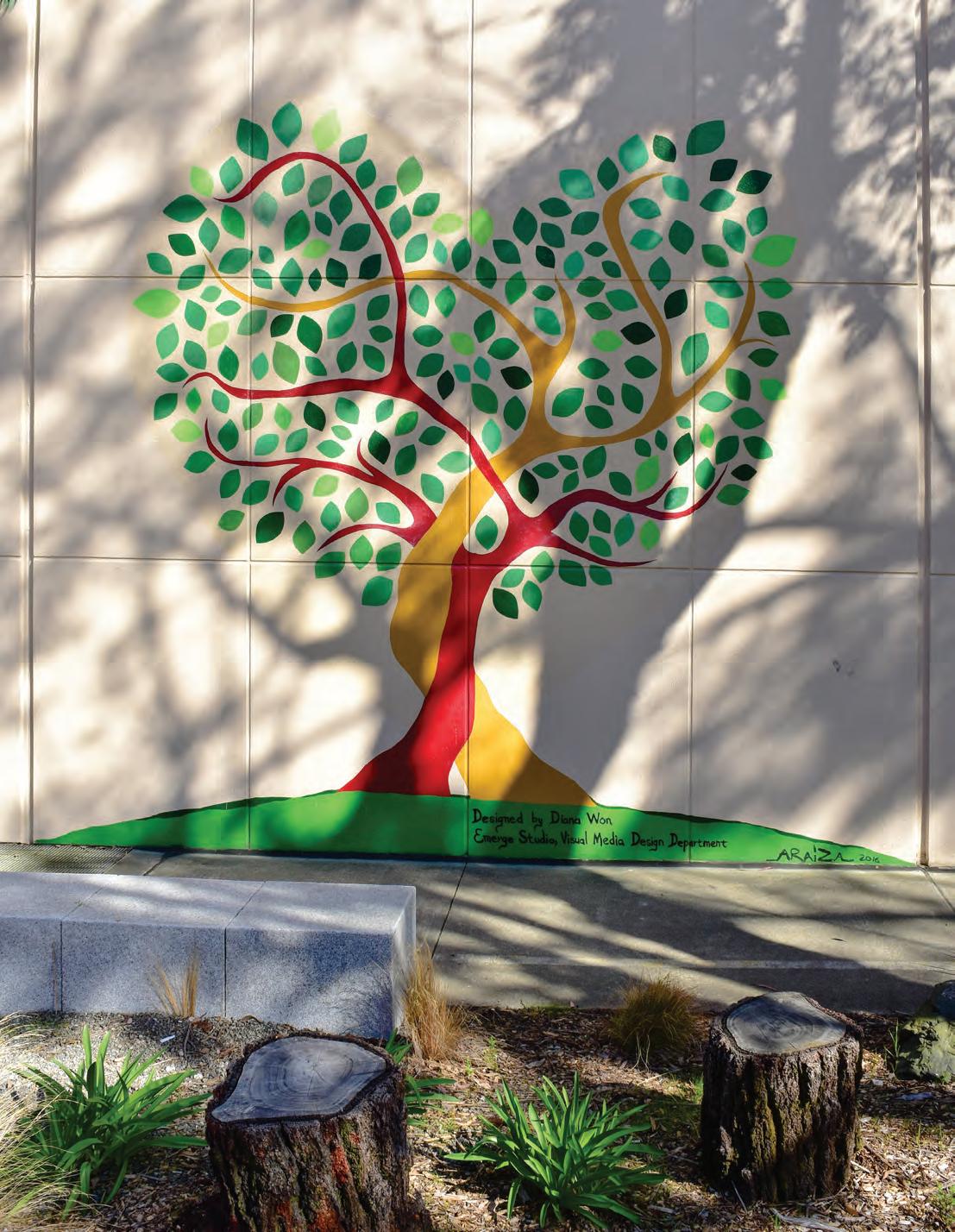 A tree casts its shadow over a mural of Project SURVIVE’s logo of a tree, designed in 2016 by Diana Won and painted by the Visual Media Design Department’s Emerge Studio.
A tree casts its shadow over a mural of Project SURVIVE’s logo of a tree, designed in 2016 by Diana Won and painted by the Visual Media Design Department’s Emerge Studio.
32 Etc Magazine
(Jennifer Yin/Etc Magazine)
ALL JAZZED UP AND NOWHERE TO GO
Jazz cannot be created on Zoom. Mario Guarneri knows this. Carrying his black trumpet case, Guarneri walks past a loading dock, through two heavy metal doors and into a large warehouse where a jazz band is rehearsing.

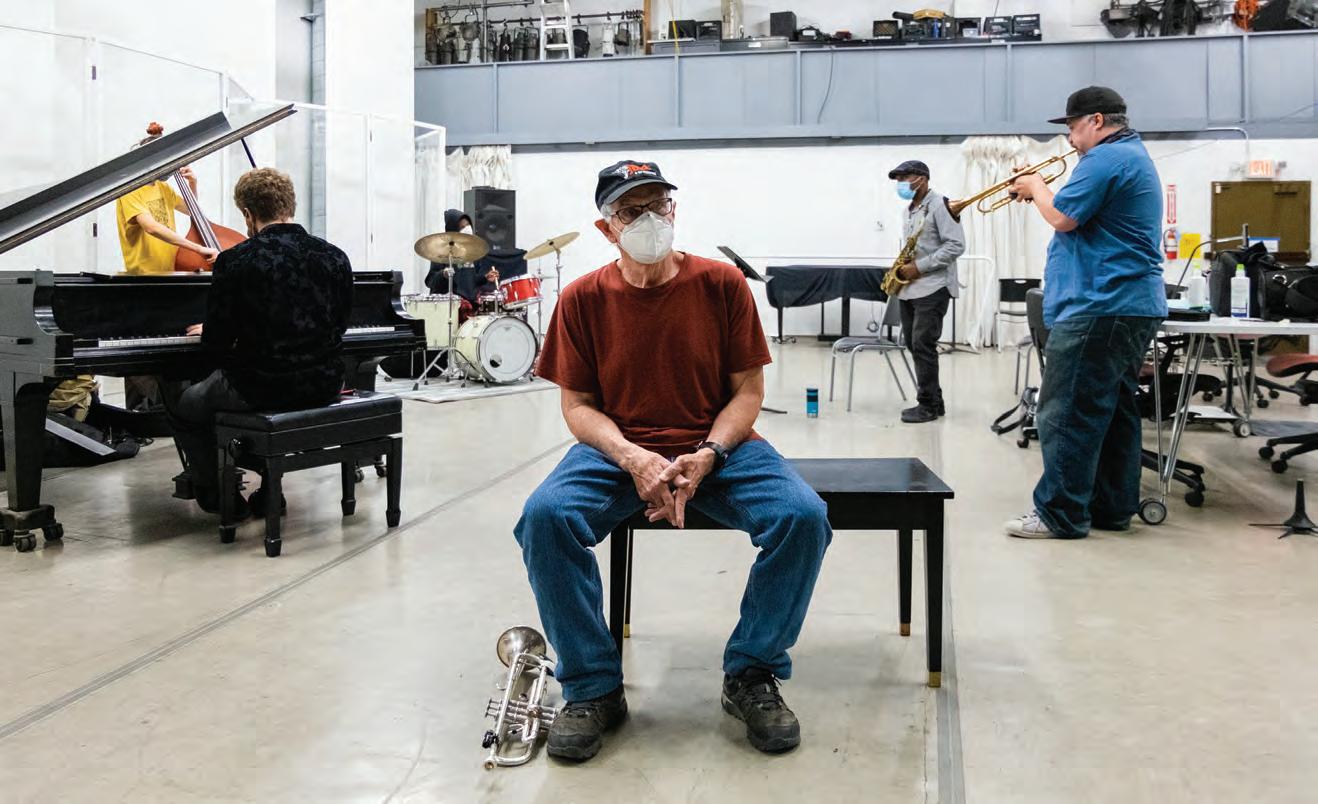
“Do you have your horn? Do you want to call the next tune?” asks Nancy Wright, a San Francisco-based jazz musician, standing with her saxophone in hand.
Positioned six feet apart from the others, Guarneri grabs his horn, and they all start to play.
It seems like a normal practice session, fluid and relaxed. Not what one would expect during a pandemic.
They are playing in a space that Guarneri created called “A Safe Place to Play,” and that is exactly what it is — a free rehearsal space for up to eight musicians to play music with established COVID-19 safety procedures.
A Safe Place to Play is across the Bay Bridge in West Oakland, within the Paul Dresher Ensemble’s studio, an industrial building
Fall 2020 33
Founder of A Safe Place to Play, Mario Guarneri, center, sits by the entrance to the practice zone. Behind him, from left to right, are Joe Warner on piano, Aidan McCarthy on bass, Genius Wesley on drums, James Mahone on saxophone and Mike Olmos on trumpet. (Emily Trinh/Etc Magazine)
Neighborhood organization provides a safe place for musicians to practice
Story by Megan Ogle Illustration by Bobby Ramirez
on a warehouse-lined street.
When shelter-in-place began suddenly in March, the music industry ground to a halt. Musicians could no longer play gigs and retreated to their homes as performance opportunities disappeared. They were left to figure out other ways to support themselves. Guarneri recognized that it would be really important for musicians to have a safe space to collaborate in person during the pandemic.
Professor of Latin American, Caribbean and jazz music at City College of San Francisco, Rebeca MauleonSantana agrees. “Many of my colleagues are creating outdoor concerts in public spaces, garages, sports fields and public parks,” she says.
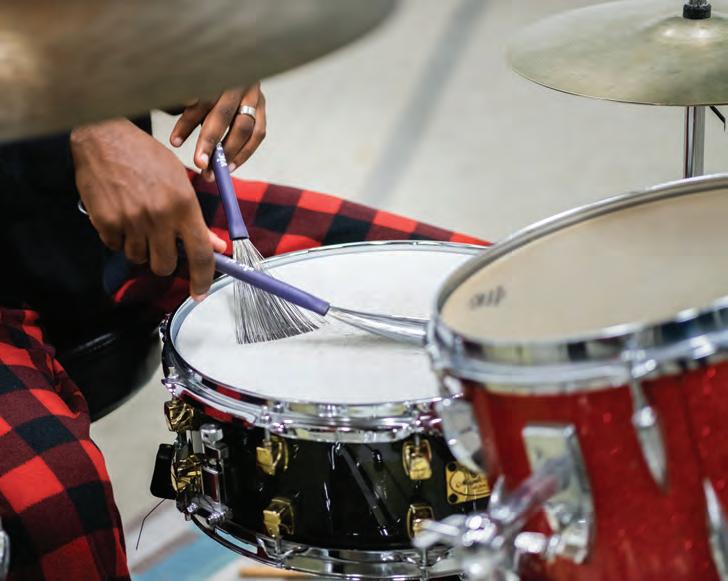
While playing outdoors has become more common, it presents its own set of challenges for particular performers according to Mauleon-Santana. “Horns and vocals are essentially taboo instruments right now,” she says, referring to possible increased exposure to COVID19 caused when a person heavily exhales while blowing a horn or singing.
Mauleon-Santana knows musicians who started to produce and release singles, others who created DJ sets and live solo concerts on social media. Some
have turned to one-on-one music lessons through Zoom and other conferencing platforms to replace lost income.
While these are good options, none address the need for collaboration and improvisation that some genres, jazz in particular, require.
A professional trumpet player and an activist himself, Guarneri knew that if he could figure out a way to rent a space, it
would allow artists to still be able to come together. He understands this is an acute need for jazz musicians. “One of the main things that is different for jazz players especially, and for any improvisational groups, is that we need to be with other people to create our music. Our music is built on the interaction,” says Guarneri.
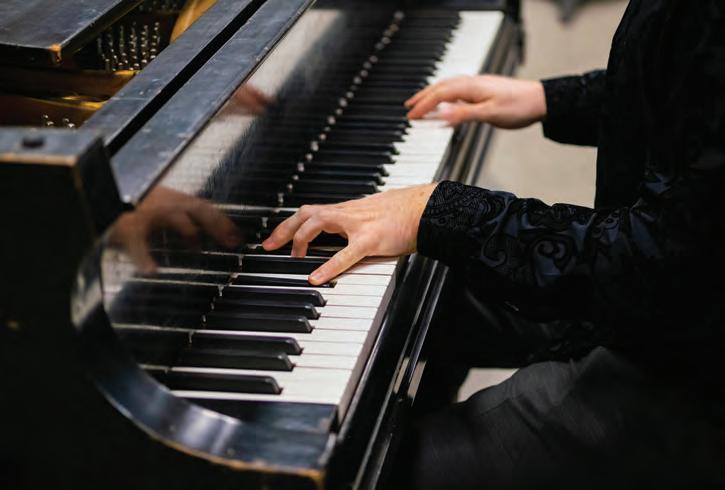
“It’s very hard to interact when you don’t have the body language and the call and response and eye contact,” says Mauleon-Santana.
Guarneri had an idea. He used his existing nonprofits to make it work. Eight years ago he started an organization, Jazz in the Neighborhood, to advocate for fair wages for Bay Area jazz and blues musicians. Jazz in the Neighborhood works with local venues to guarantee musicians’ compensation regardless of ticket sales. When venues cannot cover the full cost, Jazz in the Neighborhood supplements the difference with funding mostly obtained through donations and grants. They count on the generosity of supporters.
Just prior to the pandemic, Guarneri started another nonprofit, the Independent Musicians Alliance, a guild organization designed specifically for jazz musicians. The organization helps them develop skills, market, organize and advocate for themselves as musicians. While Jazz in the Neighborhood focuses on public performance, the Independent
34 Etc Magazine
Joe Warner’s fingers fly on the piano keys during a socially distanced jam session at A Safe Place to Play in the Paul Dresher Studio’s Ensemble room. (Emily Trinh/Etc Magazine)
Genius Wesley plays the drums during a socially distanced jam session at A Safe Place to Play in the Paul Dresher Ensemble’s studio room. (Emily Trinh/Etc Magazine)
Musicians Alliance is an organization for the musicians.
Through his nonprofits, Guarneri advo-
cates for people without a safety net. He helps musicians unite and make a liveable wage.
The conditions for jazz musicians preCOVID-19 were less than ideal, but their immediate needs shifted once the pandemic hit. Artists often had to supplement their careers with a second or third job. In a survey conducted by Jazz in the Neighborhood, it was revealed that a musician typically takes home $95 for a three- to four-hour performance.

Rather than offering a guaranteed fair wage to musicians, some venues provided musicians with a portion of profit made from a cover charge at the door and allowed musicians to collect tips. Often, musicians ended up making less than minimum wage. Guarneri created the Guaranteed Fair Wage Fund which ensures musicians make $150 per person per gig, but now with venues closed, there are no more gigs.
In April, Guarneri’s two organizations sent out $30,000 of relief aid in the form of grants to local jazz musicians, but they needed more than just money. Jazz musicians needed a place to play together and thus, A Safe Place to Play was conceived.
With funding from Jazz in the Neighborhood, Guarneri’s newer organization, the Independent Musicians Alliance started renting a space from Paul Dresher, a multidisciplinary composer who creates chamber music as well as music for theater, contemporary opera, orchestras and dance performances.
The Paul Dresher Ensemble has been in the Oakland warehouse space for 31 years. Before COVID-19, Dresher’s studio was a resource for contemporary musicians.
Dresher rented the warehouse for everything from live musical theater performances to practice space.
To make the practice area COVID-19 compliant, Guarneri and the Paul Dresher studio designed a safety protocol which anyone using the space is required to follow. Upon entering, there is a rectangular pedestal with hand sanitizer, gloves and masks. Everyone must be masked at all times unless they are actively playing a wind or brass instrument. The space is large enough for musicians to
spread out comfortably and maintain a distance of six feet.
While most musicians bring their own instruments, there is a drum set, grand piano, speakers and guitar and bass amplifiers set up for musicians to use. There are three large plexi-glass shields for vocalists, brass, and wind players to use if they choose.
As soon as musicians pack up, Gabe Lee, the marketing and media coordinator for Jazz in the Neighborhood and
Fall 2020 35
“I think the main idea right now is to keep everybody’s spirits alive with the idea that we can get back to playing.”
— Mario Guarneri
James Mahone plays the saxophone during a socially distanced jam session at at A Safe Place to Play in the Paul Dresher Ensemble’s studio room. (Emily Trinh/Etc Magazine)
Independent Musicians Alliance, grabs the nearest bottle of sanitizer and gets to work disinfecting all chairs, keyboards, music stands, drum thrones and any other surfaces that may have been touched. Regarding the protocol, Gabe mentions that he is “trying to sanitize everything that was touched whether I saw it get touched or not … I’m trying to be as cautious as I can.”
The studio ventilation system is constantly operating unless recording is in session. Between each rehearsal a highcapacity ceiling fan runs for a minimum of five minutes to cycle fresh air through the studio.
Guarneri hopes more spaces like A Safe Place to Play will pop up around the Bay Area. If the pandemic starts to wane, he wants to eventually host small audiences in A Safe Place to Play. “I think the main idea right now is to keep everybody’s spirits alive with the idea that we can get back to playing,” says Guarneri.
As San Francisco anticipates reopening, the city is making an effort to create avenues for live music. At the end of September, Mayor London Breed announced the Just Add Music permit
which would allow musicians and other performers to play in specific shared outdoor locations like sidewalks, parking lanes and closed off streets. The permit offers a safe way for businesses to book a variety of live performances, with the exception of singing or playing wind and brass instruments.
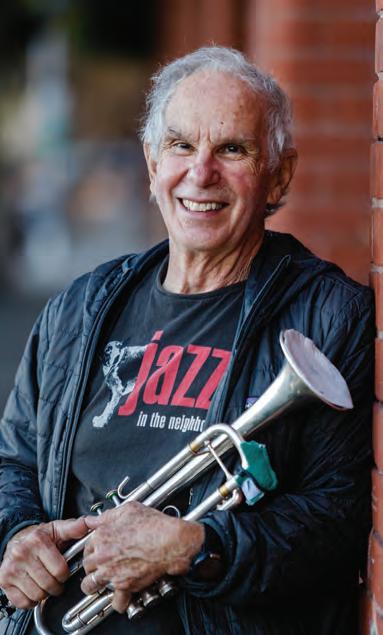
While this was a step in the right direction, indoor performance spaces have no projected reopening date. As the cold weather approaches and cases are on the rise, there may be even fewer opportunities for live music going forward.
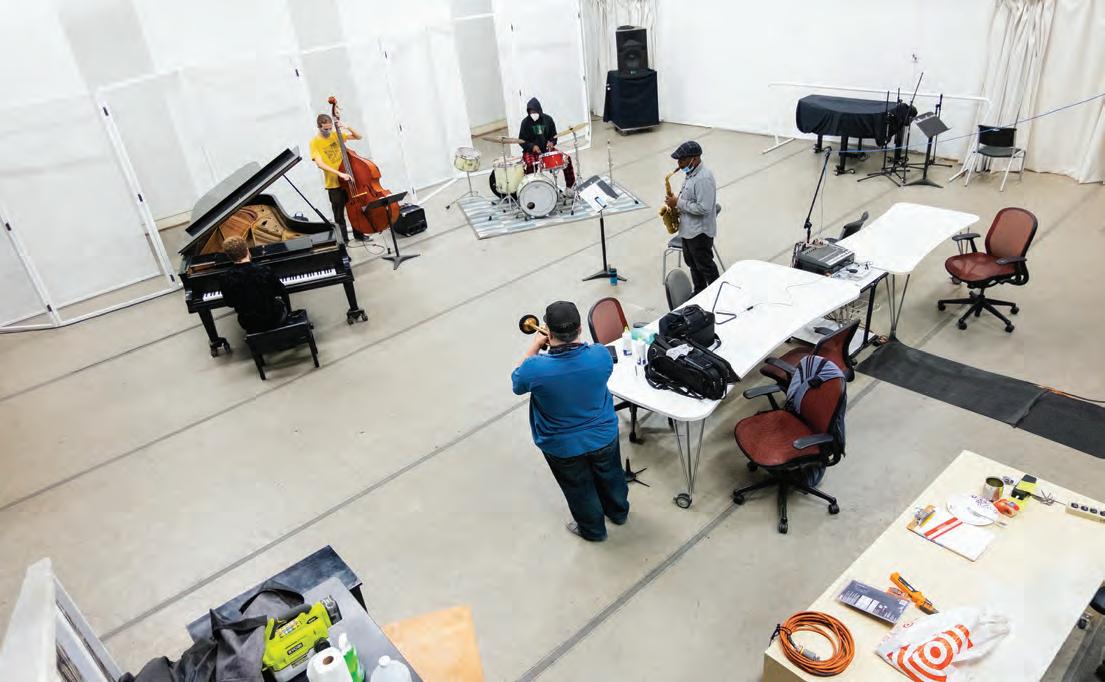
Guarneri hopes that when musicians are able to play again for an audience they will be able to return to a more sustainable business model in which musicians make a livable wage. “We don’t want to go back to the same thing we were doing before. We actually want to go back and do something better,” says Guarneri.
Back at A Safe Place to Play, Guarneri and the other musicians finish their last song. They smile as they put on their masks and pack up their instruments. The hum of the ventilation system kicks in. Lee sanitizes everything left behind to prepare for the next group.
36 Etc Magazine
Mario Guarneri covers the mouth of his trumpet with a trumpet mask, without which he’d be unable to perform in public due to COVID-19 restrictions. (Kevin Kelleher/Etc Magazine)
From left to right, Warner, McCarthy, Wesley, Mahone and Olmos play. A sanitizing station sits in the practice space, bottom left. (Emily Trinh/Etc Magazine)
JOURNALISM CLASSES
To register for courses go to www.ccsfjournalism.com
For more information call Department Chair Juan Gonzales at (415) 517–4426 or email him at jagonzal@ccsf.edu
Jour 19: Contemporary News Media
3.0 units
31191 001 Lec. T R 9:40 – 10:55 a.m. Remote Gonzales
Introduction to modern mass communication, with an emphasis on the development of the news media, analysis of the credibility of the media and its impact on daily life. CSU/UC/CAN. ADVISE: ENGL 88 or ESL 188 or readiness for college-level English
Jour 23: Copy Editing
33691 001 Lec. TR 11:10 – 12:25 p.m. Remote
3.0 units
Gonzales
This course is for writers, working editors, and those considering a career in editing or copy editing. Students learn to edit newspapers, magazines and web site articles for accuracy, style and organization. The writer-editor relationship, and ways to keep it healthy, is emphasized throughout the course. CSU. PREREQ: JOUR 21
Jour 25: Editorial Management
32474 001 Lec. M W F 11:40 – 12:30 p.m. Remote
3.0 units
Gonzales
An advanced journalism course that trains prospective print editors on all aspects of operating a publication, including developing a publishing schedule and story assignments, coordinating a writing staff, designing a page, writing headlines and cutlines, sizing photographs, understanding the business side of print journalism, and working with other editors and printers. CSU. COREQ: JOUR 24
Jour 29A: Intro Magazine Editing & Production
3.0 units
32328 551 L/L M 6:30 – 9:15 p.m. Remote Lifland
An introduction to the process of creating a magazine publication. Students work as part of a staff of writers and photographers, focusing on writing and photographing feature stories suitable for publication in the campus magazine. CSU. ADVISE: JOUR 21 or JOUR 22 or JOUR 37
Jour 29B: Intermd Magazine Editing & Production
32723 551 L/L M 6:00 – 9:15 p.m. Remote
3.0 units
Lifland
An intermediate exploration into the process of creating a magazine publication. Students work as editors focusing on editing content suitable for publication in the campus magazine. They participate in the editorial and production process and develop the skills required for publishing a campus magazine. CSU. ADVISE: JOUR 29A
Jour 29C: Adv Magazine Editing & Production
32724 551 L/L M 6:00 – 9:15 p.m. Remote
3.0 units
Lifland
An advanced exploration into the process of creating a magazine publication. Students work in management positions focusing on leading a staff in producing content suitable for publication in the campus magazine. They facilitate the editorial and production process and develope the skills required to manage the publication of a campus magazine. CSU. ADVISE: JOUR 29B
Jour 31: Internship Experience
31196 W01 Exp HOURS ARR Remote
Supervised on-campus or off-campus employment in a branch of journalism or a closely allied field. ADVISE: JOUR 24, Repeat: Maximum credit: 4 units
Jour 36: Investigative Reporting
31820 351 Lec. R 6:10 - 9:00 p.m. Remote
2.0 units
Gonzales
3.0 units
Gonzales
The course provides advanced concepts of news gathering, interviewing and writing. Students will be assigned beats covering neighborhood communities and local government. Extensive research, interviewing, meeting coverage and writing involved. Students will improve and expand their news gathering and writing skills. CSU. ADVISE: JOUR 21
Jour 38: Intmd Photojournalism
33693 551 Lec. W 6:10 - 9:00 p.m. Remote
3.0 units
Lifland
Emphasizes concepts of photojournalism at an intermediate level. Assignments will involve photographing people and visual storytelling at a professional entry-level appropriate for use in publications such as newspapers and magazines. Emphasizes integration of traditional photojournalism with new media technology reflecting current professional trends in photojournalism. Digital SLR required. CSU PREREQ.: JOUR 37
Fall 2020 37
SPRING 2021




Be the force BRING YOUR VOICE TO THE TABLE WE NEED: JOURNALISTS WRITERS GRAPHIC DESIGNERS ILLUSTRATORS & PHOTOGRAPHERS JOURNALISM 29A Magazine editing and production Spring and Fall semesters Monday 6:30 – 8:20 Email us for more info — etcmagazine@mail.ccsf.edu Monday 6:30 – 9:15


















 Alan Wong addresses an audience at The Lister Bar on election night in November. (Melvin Wong/Etc Magazine)
Alan Wong addresses an audience at The Lister Bar on election night in November. (Melvin Wong/Etc Magazine)









 Story by Emily Trinh
Story by Emily Trinh




 Designer Laura Lambert works on her sketches in her kitchen in Emeryville, California. The kitchen doubles as her her fashion studio. (Kevin Kelleher/Etc Magazine)
Designer Laura Lambert works on her sketches in her kitchen in Emeryville, California. The kitchen doubles as her her fashion studio. (Kevin Kelleher/Etc Magazine)













 Story and Photographs by Bo Lenschau
Photo illustration of a Third Parent Family grocery distribution.
Story and Photographs by Bo Lenschau
Photo illustration of a Third Parent Family grocery distribution.













 A tree casts its shadow over a mural of Project SURVIVE’s logo of a tree, designed in 2016 by Diana Won and painted by the Visual Media Design Department’s Emerge Studio.
A tree casts its shadow over a mural of Project SURVIVE’s logo of a tree, designed in 2016 by Diana Won and painted by the Visual Media Design Department’s Emerge Studio.









